Tu carrito está vacío

Thinking about buying a paddle board? This massive paddle board guide will walk you everything you need to know. Whether you’re a beginner and looking for your first board or if you’re an experienced paddler there are important paddling terms, techniques, and information to keep in mind.
You’ll learn everything from how figure out what Paddle Board is right for you, paddle board construction, SUP paddles, paddle board care, how to paddle board, advanced paddling techniques and much more. Use the Table of Contents below to jump from section to section or simply start reading from top to bottom.
Table of Contents
What is Paddle Boarding?
Paddle Boarding Terms
Anatomy of a Paddle Board
Paddle Board Types, Shapes & Performance
Types of Paddle Boards: Inflatables & Hard Boards
Paddle Board Construction (Inflatables & Hard Boards)
What Size Paddle Board is Right for You? (Hull Type, Length, Width, Thickness, Volume)
The SUP Paddle: Types, Overview & Components
What Paddle Board Paddle is Right for Me?
How to Choose the Correct Paddle Height
Accessories & Features to Look for When Buying a SUP
Paddle Board Fin Types & Configuration
Inflatable Paddle Board Pumps
Inflatable Paddle Board Bags & Backpacks
How to Paddle Board
Getting Your Board to the Water
How to Carry Your SUP
How to Properly Launch and Stand Up On Your Board
Proper Paddle board Stance and Positioning
How to Adjust a SUP Paddle for Your Height
How to Hold a SUP Paddle
How to Paddle Properly: 3 Basic SUP Strokes
Sitting or Kneeling on Your Paddle Board
Falling Off and Getting Back On Your Paddle Board
Common Paddle Boarding Mistakes and Tips For Your First SUP Outing
Advanced Paddle Board Techniques
How to Ride a Paddle Board with a Passenger
How to Care For and Store Your Paddle Board and Accessories
How to Repair Your Paddle Board
How to Patch your Inflatable Paddle Board
How to Repair Your Hard Paddle Board
Types of Electric Pumps for your Paddle Board
How to Properly Store your Paddle Board (Inflatable and Hard Board)
How to Transport Your Paddle Board
Stand Up Paddle Boarding (or SUP) is a relatively new sport where the rider stands on his board using a paddle to propel himself through the water. There are several different types and variations of paddle boarding such as: flat water paddling, sightseeing, recreational, fitness, paddle board racing, river and white water paddle boarding, paddle board surfing, paddle board fishing, and paddle board yoga.
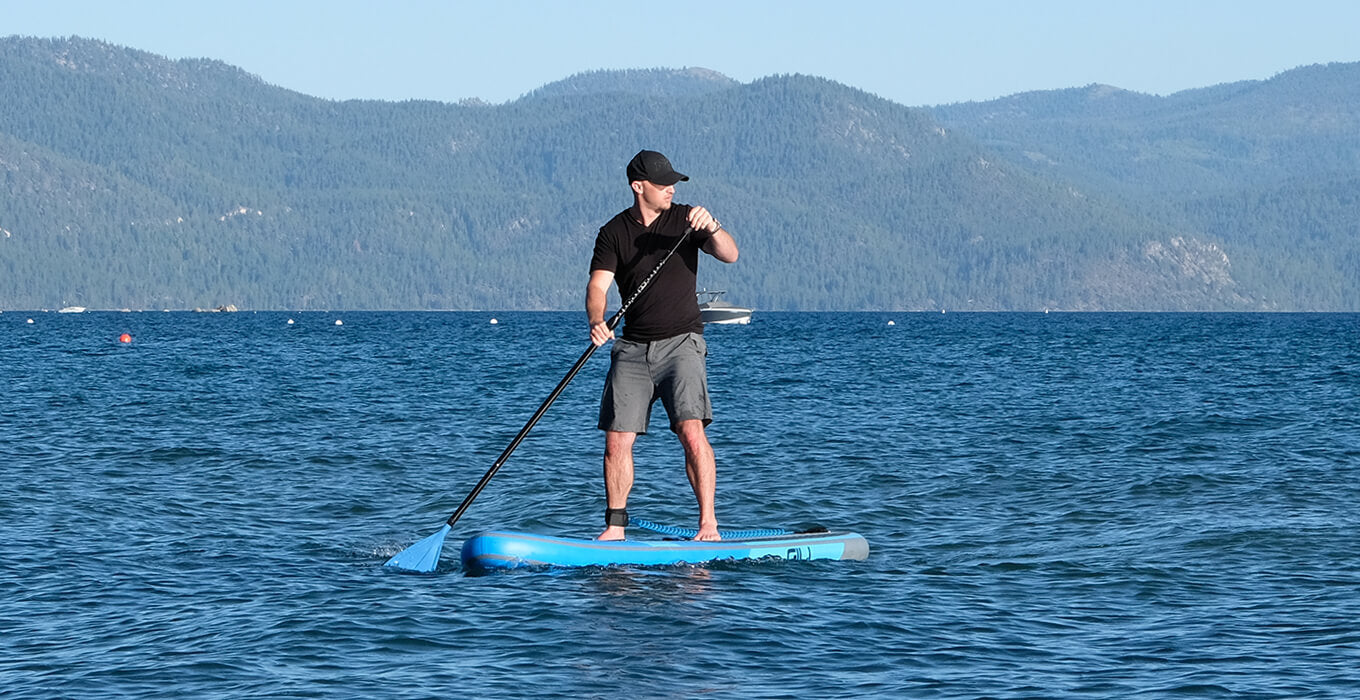
Surfers, as opposed to Paddle Boarders, typically will wait in a swell for a wave to ride where paddle boarders can ride on flat water or in surf. Clearly, paddle boarding was inspired by old school surfers, but some say paddle boarding has roots dating back to thousands of years ago.
If you’re new to the SUP world you should know the sport’s general terms and anatomy of a paddle board. Whether you’re looking online or you’re in a retail shop, this guide will help you find the right board for you. These basic terms are used by nearly every manufacturer in the paddle board industry.
General Paddle Boarding Terms:
Adjustable Paddle:Most paddle board paddles can be adjusted for the height of the rider, different conditions and different paddling techniques. Check out How to Adjust and Hold the Paddle
Blade:The blade is the lower flat part of the paddle which you use to propel yourself on the water
Bottom: the bottom, or underside of a stand up paddle board
Bungee: many paddle boards have a bungee system to secure your belongings while you’re paddling. Typically made up of elastic cored secured to the SUP deck with d-rings
Buoyancy/Volume: This is the amount of water the board would displace if completely submerged. The volume of the paddle board directly relates the buoyancy of the board. Higher volume boards can support more weight, and are generally more stable. However, higher volume boards can come at the cost of speed and weight. It’s important to choose the correct volume board for your weight and the gear (if any) you’ll be carrying.
Carbon Fiber: a very strong, lightweight material sometimes used to make performance paddle board parts such as paddles, fins, and paddle boards. Carbon fiber is an expensive material and is more common on higher end, performance oriented boards.
D-Ring:a metal “D” shaped ring used to secure a leash, and/or bungees to your paddle board
Deck:the entire top side of your paddle board
Deck Pad/EVA Pad: a grippy, soft grip pad on your paddle board. This is the area where you place your feet on the board, usually made from EVA material.
Displacement Hull:the nose of a board shaped like a kayak, often found on racing paddle boards for cutting through the water
Doming/Domed Deck: Some hard paddle boards may have a domed profile for higher performance in surf conditions
Downwinder:paddling with the wind at your back. This could be along a coast or body of water, and often with a different pick up point.
Drag:drag is caused when something is hanging in the water. Your leash, hand, foot or leg will cause drag when paddling.
Dropstich/Crosstitch:inflatable paddle boards are made of dropstitch material. This material has stringers, or fine threads, between the top and bottom layers of this board. This is what gives the an inflatable paddle board it’s shape and rigidity. Without this technology, inflatable paddle boards would not be possible.
Fiberglass:commonly used in hard paddle board construction because of its strength and lightweight qualities. Fiberglass is a type of reinforced plastic using glass fiber and is relatively inexpensive.
Fin:the fin is an essential part to the paddle board typically located on the tail of the board. The fin provides lateral traction and grip while paddling. Paddle boards can come with several different fin setups: single fin, single fin with side bites, triple fin, and, rarely, even quadruple fins.
Fin Box:is where the fins are attached to the board. The most common fin box is called the “US Fin Box,” however there are various types of fin boxes on the market.
Flutter:a flutter occurs when there is a shake or wobble of your paddle during the power phase of your stroke. A paddle with a flutter will tire you out quickly. Something is wrong with your paddle if it flutters
Foam:some hard paddle boards are filled with foam as it’s easy to shape and very lightweight.
Handle:a handle can refer to the handles and grips on your paddle board, and it can also refer to the t-grip handle of a paddle.
Inflatable Pump:an inflatable pump is used to inflate and deflate inflatable paddle boards. Hand Pumps can be single, dual or triple action. We generally recommend you look for at least a dual action pump as it will significantly decrease the time and effort when inflating your paddle board compared to a single action pump. There are also many electric paddle board pumps on the market.
Leash:a leash secures the board to your ankle and should always be used. Coiled leashes are most common and recommended leash choice for paddle boarding
Leash Cuff:the nylon material of a paddle board leash which wraps around ankle.
Leash Plug:A leash plug is common on hard paddle boards where you attach your leash
Leverlock:a commonly used type of adjustment system for paddles
Life Jacket/Life Vest:a life jacket keeps you afloat if you fall off your paddle board. Be aware of local laws when paddle boarding and always be safe!
Nose: generally, the front of your paddle board
Nylon: a common material for the blade of paddles because it is lightweight, durable and relatively inexpensive
Pad: The soft material where you place your feet on a paddle board. See Deck Pad/Eva Pad
Paddle Clamp/Pins:
Planing:when your board rides over the water rather than pushing through, similar to surfing.
Planing Hull: a type of paddle board hull designed to skim over the top of the water like a surfboard
PSI/Pressure Gauge:PSI stands for pounds per square inch and is used to measure how much air is pumped into your board. Paddle Board Inflatable Pumps will have a pressure gauge so you know when your board is full. Often times the PSI Gauge will not read until you 7-8 PSI
Rails:the sides/edges of your paddle board are called rails. Rail shape plays a big part in your board’s performance and stability. Rail design is very important when using a paddle board for surfing.
Rocker:an important aspect of paddle board design. The rocker is the amount of curve of the underside of the board from tail to nose. If you lay your board on flat ground, the rocker is easily noticed by how much the nose and tail lift from the ground. Flat water SUPs don’t need as much rocker as a river or surf paddle boards
Shaft:the long, cylindrical part of a paddle made from aluminum, fiberglass, or carbon fiber connecting the handle to the blade. The shafts on most paddle boards are adjustable, and some can be broken down into three pieces for travel.
Skin:another name for the top and bottom PVC layers of inflatable paddle boards
Stability:refers to how stable, or steady, your SUP is in given water conditions.
Stroke:is the action of propelling yourself forward with your paddle. There are three phases of of the stroke: the catch, power phase, release and recovery. We cover paddling and stroke technique here
Tail:in most cases the rear portion of your paddle board
Tracking: refers to how well your board naturally goes straight when on the water The paddle board fin(s) help with tracking
Valve:usually a Halkey-Roberts style valve on the rear of your board which you connect your pump to inflate your board. This high pressure valve is part of the technology that helps inflatable paddle boards feel so rigid when fully inflated.
Valve Cap:the valve cap protects against accidental deflation of the paddle board, and protects the valve from dirt and water.
Valve Head/pin:is a spring loaded pin that controls the valve seal. There are two positions: open and closed which are activated by turning and pushing/pulling the fin. When the head is the up position the seal is closed but allows inflation. In the down position the seal is open and allows you to deflate the board.
Volume:see Buoyancy/Volume
Vent and Vent Plug:found on hard boards, vent plugs allow gasses to equalize prevent damage when storing your hard paddle board
Now that we've covered common paddle board terms, it's time to see what they look like on the board. Check out the diagram below. You can see the anatomy of an Inflatable Paddle Board. Inflatable Paddle Boards are nearly identical to their hardboard brethren in terms of features - with one major exception. A hard paddle board will have a vent plug instead of an inflation valve, usually near the tail of the board.
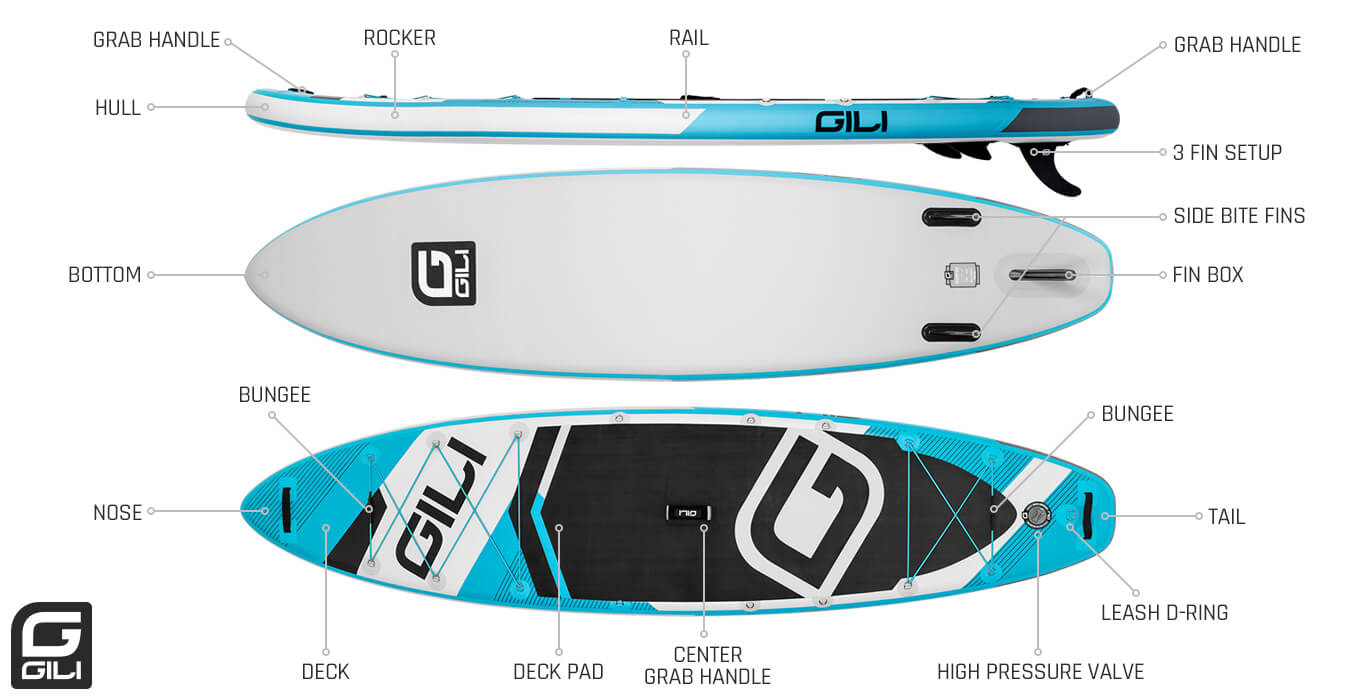
What are the different types of Stand Up Paddle Boards? Depending on who you ask, there are many different types and shapes of paddle boards. We cover the most common types below.
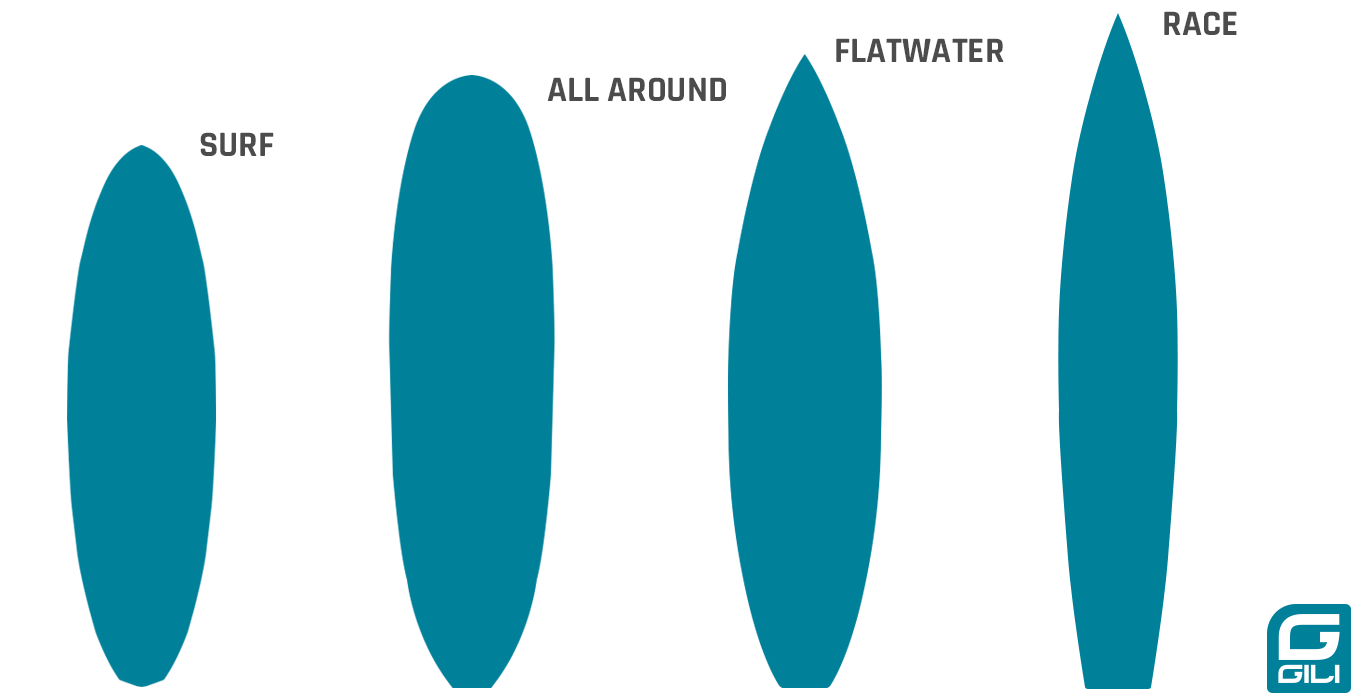
All-Around Paddle Boards
If you’re new to Paddle Boarding you’ll probably want to consider an All-Around Paddle Board for your first SUP. These boards perform well in flat water and small waves, and they are also very stable. Just like their name suggests, these boards do most things well but won’t be as fast as a race paddle board or as nimble as a surf paddle board.
We often recommend all-around paddle boards so you can enjoy everything the sport has to offer. All-around boards are usually larger than 10 feet x 30 inches, and are thicker than surf or race models. A 10’6 board seems to be the ideal all-around paddle board for most paddlers.
Surf Paddle Boards
Surf paddle boards are shorter and more agile than all-around paddle boards, and have a narrow nose and tail. Surf paddle boards will usually have a higher rocker (the side of the board that curves) than most other paddle boards. If catching waves is your thing, then a surfing paddle board is going to be your best bet. Keep in mind that surf paddle boards tend to be less stable than the all-around SUPs.
Surf paddle boards are usually slower to paddle, but their narrow shapes make catching and maneuvering on waves easier. If you’re new to catching waves, start on a longer board. The smaller the board the harder it is to catch a wave. You’ll need to learn how to navigate waves with your surf SUP, as you won’t be able to duck dive (diving under an oncoming wave with the board beneath you) with a paddle board.
Flatwater Paddle Boards
Flatwater paddle boards excel at traveling long distances over, you guessed it, flat water! A flatwater SUP is generally narrow and longer than all-arounder boards, and will generally have a more pointed nose to cut through the water quickly and efficiently. What a flatwater SUP gains in speed and efficiency, performance in waves and chop will not be as good as other boards. Most flatwater boards will be stable enough for beginners, but be aware of very narrow flatwater sups if you are new to the sport.
Touring and Race Paddle Boards
Racing, or Touring Paddle Boards are similar in shape to flatwater paddle boards, but are generally even longer and narrower. These boards are for experienced paddlers as they are the least stable type of board, and their long length makes maneuvering difficult. However, touring and race SUPs are the fastest boards out there, and the can cut through chop easily.
We recommend touring and race paddle boards for skilled paddlers only. If you’re a beginner, you should choose one of other paddle types before trying a race board.
Yoga Paddle Boards
Paddle Board Yoga is an awesome, new way to do Yoga! Imagine practicing yoga on the tranquil, calm waters of a lake surrounded by the forest and trees - you can’t get that environment in the studio. SUP Yoga classes actually started around 2008, and the sport is continuing to grow. What actually makes a paddle board good for Yoga?
You’ll find many different sizes and shapes of paddle boards. The good news is a Yoga Paddle Board can be used recreationally just like an all-around paddle board. Here’s what to look for in a paddle board if you’d like to use it for yoga. Look for more rounded nose and at least 10 feet in length for your Yoga SUP. You’ll typically want a board that’s at least 30” wide or more for stability, and we prefer yoga boards with large, smooth traction pads which are more comfortable when laying or sitting on the board. Most yoga boards have a way to tie up your paddle, which is important if you’re far off shore. A bungee system is also nice to have to store a water bottle, shoes, while paddling and practicing yoga.
Both Inflatable Paddle Boards and Hard Paddle Boards perform well for yoga, but we do recommend an Inflatable Yoga Paddle Board to most people as they’re easier to store, carry and use.
Fishing Paddle Boards
Fishing Paddle Boards are great for amateur fishers and hardcore fisherman! Sometimes you don’t want to invest in a boat or kayak just to fish, but you still don’t want to be limited to fishing the shore. Like Yoga SUPs, fishing paddle boards can also be used recreationally.
Fishing Paddle Boards tend to be longer and wider than most other SUPs. Most fishing paddle boards are longer than 11’ and wider than 33,” which allows for more room to fishing gear, tackle, and an ice chest. Fishing boards will should have at least one bungee system. Look for a board with built in mounts (often “Scotty” mounts) for your rod, fish finders, cleaning trays etc.
Fishing Paddle Boards can typically carry a lot of weight, but they sacrifice some speed to do so. When you’re not fishing, these boards are ideal for cruising with your kids, significant other, and your four legged friends.
Windsurf Paddle Boards
A Windsurf Paddle board typically has an all-around shape, but features an attachment near the center of the board for a windsurfing sail. Windsurf SUPs will also have a fin in the very center of the board, which is unusual for standard paddle boards. This middle fin can be removed if using the board as a standard SUP, or when windsurfing in strong winds.
Owning a Windsurf Paddle Board can be tons of fun, but we recommend them for experienced paddlers, and you need to know the basics of windsurfing to be able to maneuver and use the board and sail effectively.
Whitewater & River Paddle Boards
Not for the faint of heart, whitewater river paddle boarding can be fun, exhilarating, and of course a little dangerous. For a SUP to well in whitewater, they require a few unique features.
Typically, whitewater paddle boards will be shorter, under 10 feet, for maneuverability, and can be wide or relatively narrow depending on your skill level. Narrower boards will be more maneuverable, but will be harder to balance. Whitewater SUPs need to be constructed of a durable material, such as polyethylene (PE) to survive the tough river conditions.
Inflatable Paddle Boards are becoming a new trend in Whitewater paddling, as they can hold up better than hard boards. Look for the same qualities in an inflatable as you would in a hard whitewater SUP. Look for a board made with at least dual layer, high strength PVC material, and with a removable fin. We suggest looking for a board wider than 33” and and no taller than 10’ - if you love river running you’ll want the smaller board for better agility. Keeping it wide will give you stability without sacrificing too much agility.
Whitewater paddling is a serious sport for advanced paddlers. If you’re new to the sport consider getting an all-around or touring paddle board.
You’ve probably noticed there are two major types of paddle boards: inflatables and hard boards. But which should you choose? We’ll explain the main differences here and get into the actual construction of hard boards and inflatables later in this guide.
Inflatable Paddle Boards are often referred to as iSUPs, and hard boards are often referred to as epoxy, fiberglass or traditional paddle boards.
You may have been told that one type of paddle board is better than the other. We’re here to tell you that’s simply not true. What matters most is getting the right type of board for you. Both Inflatable Paddle Boards and Hard Paddle Boards have their pros and cons.
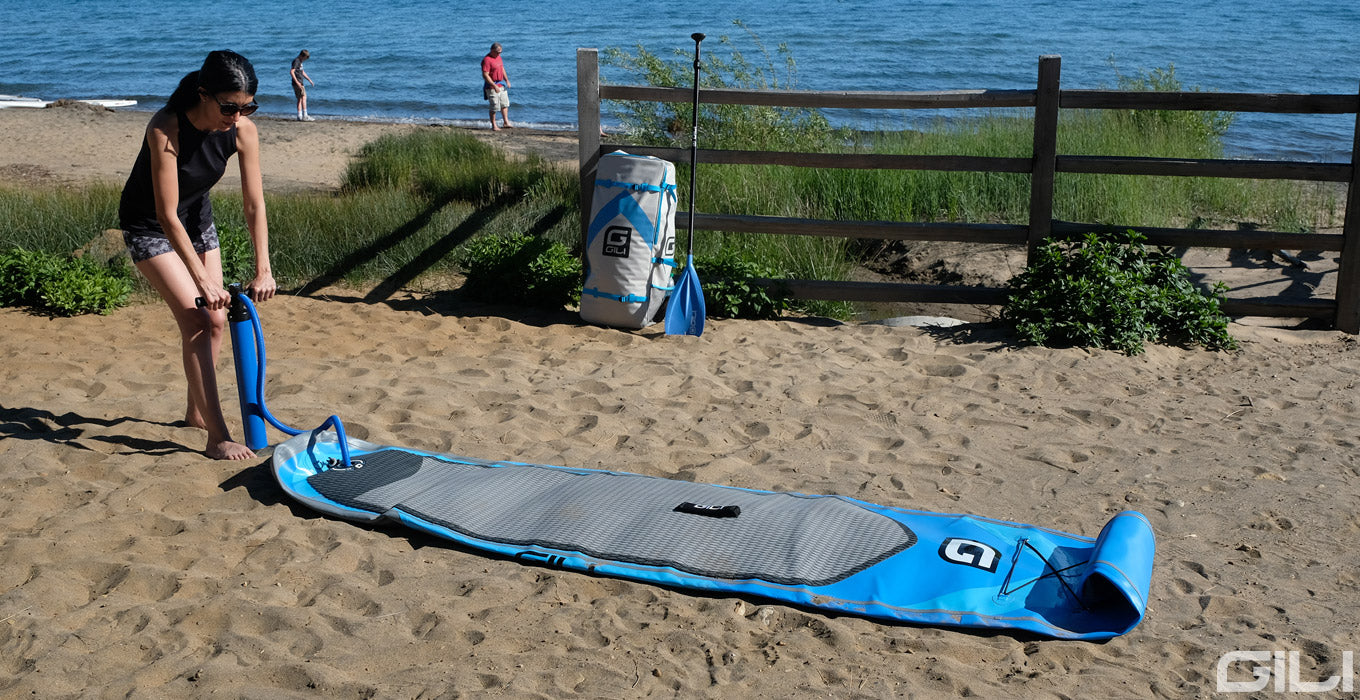
Here are the 7 Factors You Need to Consider when Choosing between a hard paddle board and an inflatable.
Primary Use: How will you use your board?
How do you plan on using your paddle board? This should be your main concern when choosing between a hard paddle board and an inflatable.
If you don’t plan on using your SUP for surfing, racing, or very long distances buy an inflatable board. Inflatable SUPs can be fine for some small surf, but if your primary use is for racing or surfing look for a hard board.
If you’re looking for a paddle board for white water paddling an inflatable SUP is the way to go. Inflatables will be more durable and maneuverable in river rapids.
Hard boards are typically a little faster than inflatable boards, so if you’re looking for maximum speed a hard board is right for you. However, if you’re a beginner, stability and maneuverability should be a bigger concern over speed.
If you’re using your SUP for Fishing or Yoga an inflatable or hard board will work just fine. We prefer inflatables because of their ease of transport and storage, but both perform equally well for SUP fishing and SUP yoga.
Portability
One of the primary advantages of an inflatable paddle board is portability. Nearly all inflatable sups can fit in a regular car trunk and can even be checked when flying. Inflatable boards also tend to be up to 8-12 lbs lighter than a hard board. That doesn’t sound like much, but it makes a big difference lugging your board from your car to the water.
If you don’t mind taking a few minutes unloading and pumping up your board, and inflatable is for you. If you’ve got a big car or a roof rack you may want to pick up a hard board. Most people will be able to unload and pump up an inflatable sup in less time it takes to unload a hard board.
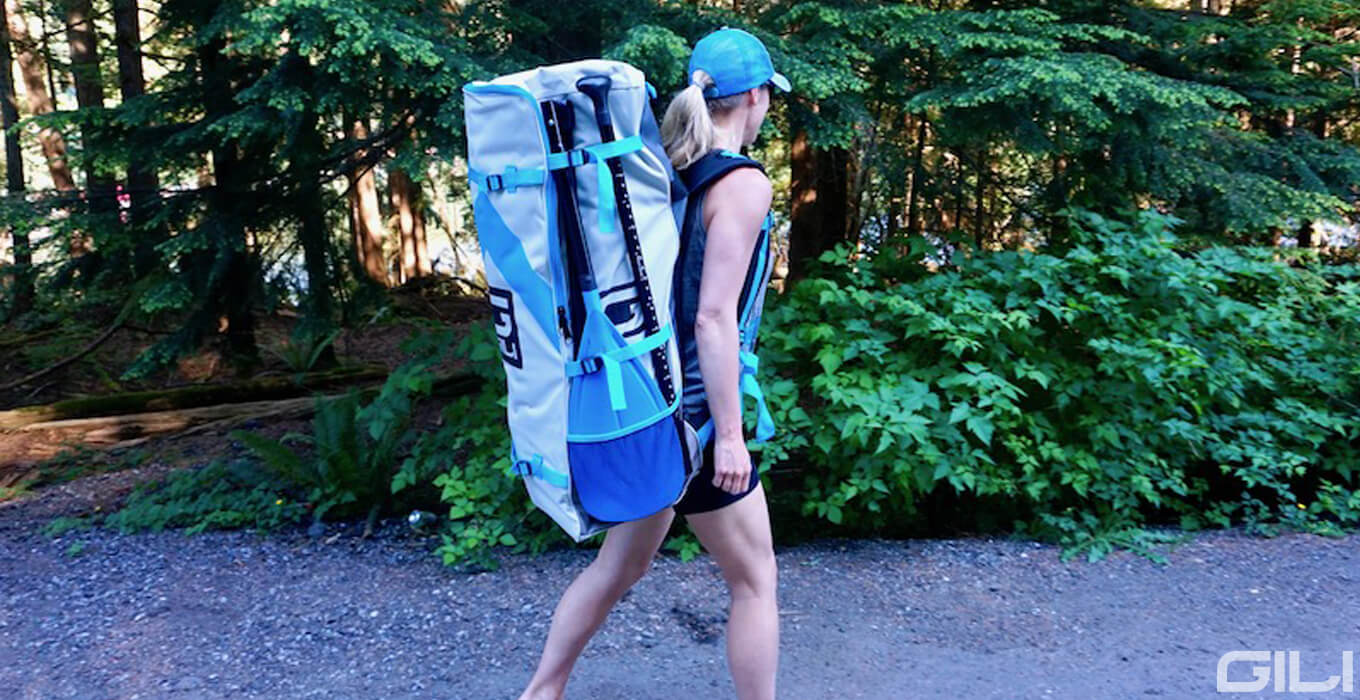
Performance
Overall, hard paddle boards outperform inflatables for surfing, SUP racing and extreme long distance paddling. If you’re an advanced paddler and performance is your biggest concern, look for a hard paddle board.
However, keep in mind inflatable paddle boards can perform almost as well as hard boards. We recommend most beginners buy an inflatable board for their first SUP.
A solid board will have more rigidity than inflatables, and are better suited for long distances. Hard boards tend to be more responsive as well.
Keep in mind that a surfing SUP will not be as fast as a racing SUP, nor will the racing SUP perform well in waves. Many advanced paddlers end up buying multiple boards; they may have an all-around inflatable SUP for cruising and a surf sup for surfing, etc.
Transport & Storage Space
Clearly, iSUPs have the advantage here. If you don’t have a garage or shed to store a hard paddle board, you should get an inflatable SUP. You’ll need a truck or car with a roof rack to safely transport your hard SUP, but you only need some trunk space for an inflatable. Inflatable paddle boards can be stored rolled up inside a close or small storage space.

Durability
Believe it or not, inflatables are more durable than hard boards. Hard paddle boards pick up more dents, dings and scratches than inflatable boards. Most inflatables are made out of premium grade PVC material which is surprisingly strong and resistant to tears.
If you’ll be paddling in rivers or white water, an inflatable is a clear choice. With a hard board, hitting a rock can end your session immediately, with an inflatable there’s a much smaller chance a rock will damage your board. If you don’t want to worry about drops and dings, get an inflatable sup. If you drop or damage your hard board, you may need to have the board repaired before you can use it again.
Skill Level
Riders of all skill levels and enjoy hard boards and inflatable boards, we generally recommend inflatables to new paddlers. You’ll typically have a more fun, carefree experience with an inflatable paddle board, and inflatables are just as stable as hard boards.
Remember, there are performance inflatable and hard boards which are for more experienced beginners. If you’re a beginner, choose a board that’s at least 10 feet and 31 inches wide - in a hard board or an inflatable.
Once you have more experience paddling, you can look into narrower or shorter boards for more performance.
Price
Inflatable paddle boards tend to be more affordable than their hard board brothers. If you’re on a budget, we recommend an inflatable board. If you plan on buying a hard board, don’t forget additional costs like storage, roof racks and travel costs if you plan on flying with your board
You should buy an inflatable paddle board if:
You should buy a hard paddle board if:
Hard paddle boards and inflatable paddle boards have very different methods of construction. You may want to know the differences between them, and what to look for when buying a hard board or inflatable sup.
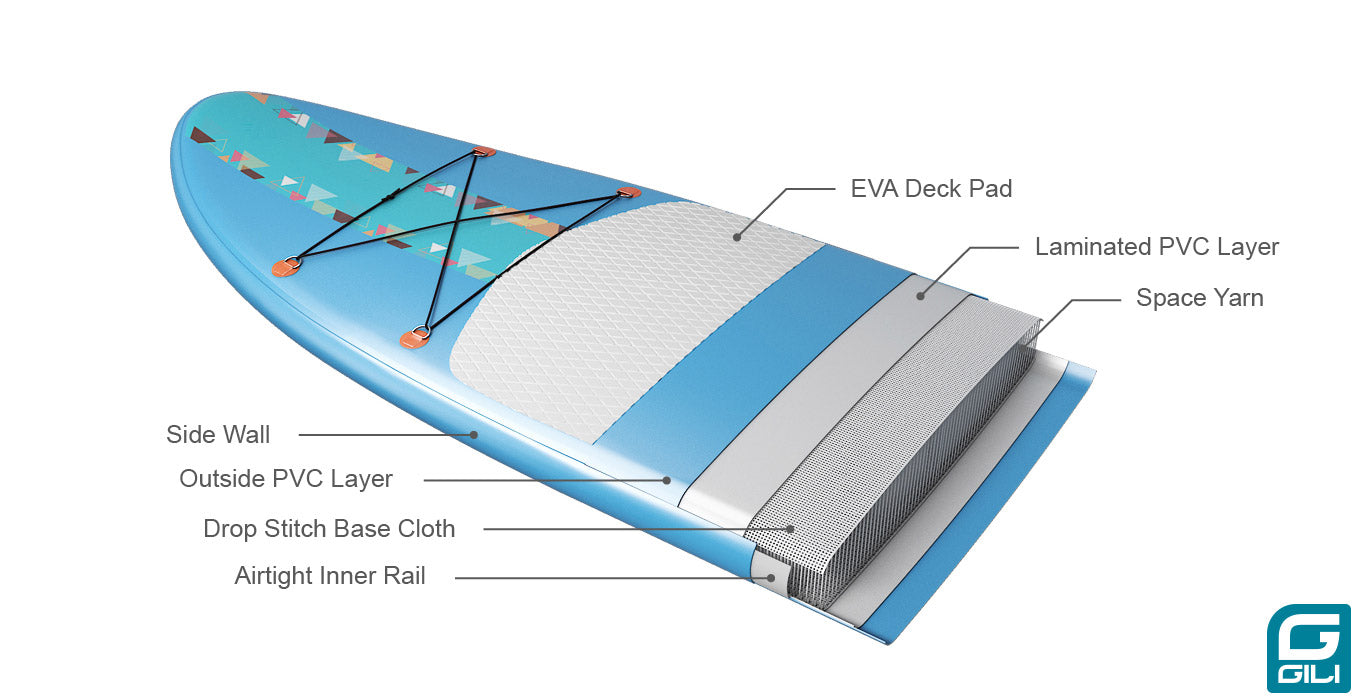
Inflatable Paddle Board Construction
The most important innovation for inflatable paddle boards have been the use of drop stitch construction. As you can see in the diagram, the drop stitch PVC material has interwoven fibers stringing from top to bottom inside the board. This is what allows the board to inflate evenly so the the surface and bottom of the board are completely flat. If you’ve never stood on an inflatable board, they feel like a hard board when fully inflated. The first time I stood on an inflatable paddle board I was blown away!
The top, bottom and rails of an inflatable paddle board are made of super strong PVC material, similar to the material white water rafts are made from. The top and bottom layers are often laser cut, and the rail wraps the top and bottom layers together. Strips of PVC are used on the rail, and industry strength blue is used to keep it all together.
The the deck pad, (where you stand) is made of ethylene vinyl acetate, hence the commonly used name EVA Pad or EVA deck pad. The material is similar to rubber, but it is softer and more durable. Deck pads can be smooth, diamond-patterned, and other patterns depending on the style and use of the board.
Another important innovation of inflatable sups is, of course, the high pressure valve. This valve, sometimes called a Halkey Roberts valve, allows the board to be pumped up to 12-15 PSI or higher. The high pressure air inside these boards are what gives the board extra rigidity - similar to a car tire, although car tires are usualy inflated to over 32 PSI. The iSUP’s high pressure valve also has a special twist lock pin. When you’re pumping the board, the pump hose will open the twist lock, when releasing the hose the pin is rotated counterclockwise and up (via a spring) which stops the compressed air from escaping. When you’re ready to deflate, simply push down and rotate clockwise to open the seal. Be warned, the board will release a gust of loud, high pressure air when you open the seal - the loud noise can frighten you the first time you deflate your board.
Single Layer, Double Layer, MSL construction - what does this all mean?
When shopping for an inflatable paddle board you’ll often hear terms thrown around such as single layer, dual layer, MSL, and a dozen other terminologies board companies are using to sound unique. We’ll explain what these all mean and the pros and cons of the different types of board construction.
Single Layer Board Construction
Single layer technology has the advantage of being lighter and cheaper then other construction methods but at the expense of being slightly less durable. The single layer, dropstitch material is used for the top and bottom layers of the board, and the rails of the board are often reinforced with a second layer of PVC material. The single layer dropstitch material is not airtight on it’s own, so a liquid PVC layer is poured over the dropstich. Once dried, the liquid PVC layer forms an airtight seal.
Single layer inflatable paddle boards can be great boards: they are more affordable, lighter, and easier to transport them other boards. Single layer boards are a great entry level boards, however they will be a little less durable and not as stiff as double layer and MSL boards.
Dual Layer Board Construction
A dual layer inflatable paddle board begins with single layer construction, and then a second layer of PVC is hand glued to the top and bottom layers of the board. The extra layers increase rigidity and durability, but do add some weight to the board. Some paddlers may not notice this extra weight, but expect a dual layer board to be several pounds layer than it’s single layer counterpart.
MSL Construction
MSL construction, also known as laminated double layer construction, is newly developed technology that we believe is superior to both single layer and dual layer board construction.
Instead of hand gluing a second PVC layer, MSL construction starts with a laminated dual layer PVC skin. An industry grade special adhesive is applied to the first drop stitch layer, and then a second PVC layer is machine laminated directly to the first layer. A MSL laminated double layer board will typically be 20-25% lighter than the equivalent dual layer board, and the MSL board will be free of small wrinkles and imperfections common on hand glued dual layer boards.
MSL boards are pricer than single layer and dual layer boards; if you’re on a budget MSL construction may not be the way to. However, ff you’re looking for the best performing, rigid, and lightweight inflatable paddle board possible, go for MSL construction every time.
Traditional Hard Paddle Board Construction
When choosing a hard paddle board, considering their construction methods is important to make sure you get the right board for the right conditions. Popularized long after kayaking and surfing, paddle board construction adopted the technology from these earlier sports shortening the manufacturing learning curve and technical issues common in new industries. We’ve covered the most common hard paddle board construction below.
The four most common methods of hard paddle board construction are wood sandwich construction, advanced sandwich construction, carbon, and pop out.
All of these methods use of an EPS, or expanded polystyrene, foam. This is a closed-cell foam - think of the foam coolers you can find in many stores. The foam itself is invulnerable to water, but if water gets into the spaces between the foam you have problems. To prevent water from seeping into the board, the foam core is surrounded by a variety of different methods.
Foam density also varies by manufacturer. It’s important to note that using less dense foam will make for a lighter core, but the less dense foam will also be less durable. In order to make a durable board with lower density foam, the manufacturer needs to compensate with stronger materials surrounding the foam core.
We’re going to get a bit technical below: if you don’t fully understand the information below - that’s ok. If you can get a general idea of the different types of construction - that’s good enough.
Wood Sandwich Paddle Board Construction
The most common type of SUP construction is the wood sandwich construction. You can find paddle boards in a wide variety of price ranges using this method of construction.
Featuring a foam core wrapped in fiberglass, a wood veneer, and then more fiberglass. As mentioned earlier, the number of layers, weight, fiberglass, and foam core density will vary by manufacturer. Remember, more layers typically add durability but also add weight. Most manufacturers use a north-south and east-west fiberglass mats to make the board lighter and stiffer. Often, manufacturers will add PVC in the area where you stand to add strength. On the top of the board there is another sandwich of fiberglass, wood veneer, and another layer of fiberglass on top. Wood sandwich construction boards are often painted, and some are finished with a clear coat so you can see the woodgrain veneer. The core of the board is sandwiched on the top and bottom in much thinner layers. Think of it like a sandwich within a sandwich.
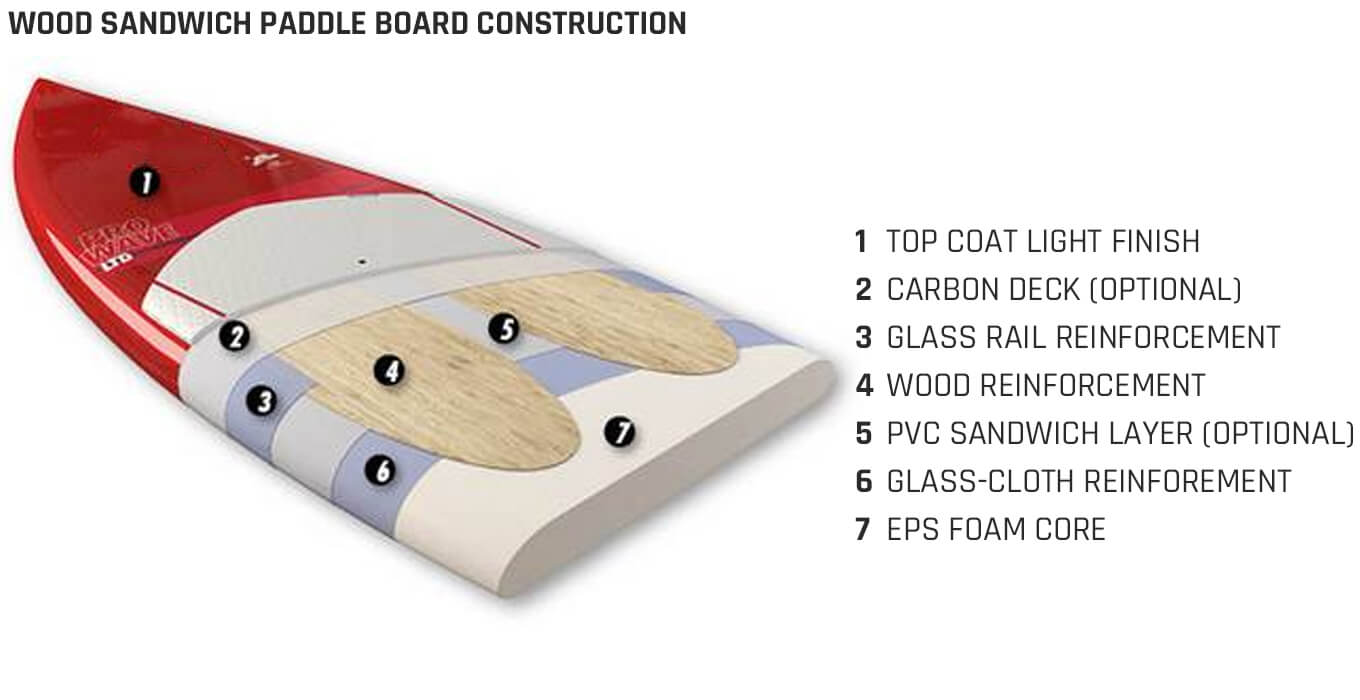 Almost all medium to high price range sandwich SUPs will be vacuum bagged. The advantage of vacuum bagging is that the manufacturer is able to obtain a lamination that uses only enough epoxy resin that is free of voids (spaces between the blank and epoxy saturated cloth). Vacuum bagged laminations have a higher strength to weight ratio than hand laminated boards.
Almost all medium to high price range sandwich SUPs will be vacuum bagged. The advantage of vacuum bagging is that the manufacturer is able to obtain a lamination that uses only enough epoxy resin that is free of voids (spaces between the blank and epoxy saturated cloth). Vacuum bagged laminations have a higher strength to weight ratio than hand laminated boards.
How does vacuum bagging work? Vacuum bagging is used to apply pressure to a lamination to make it conform to a mold. The manufacturer places the mod with wet composition lamination and a layer of peel ply (fabric that will not adhere well to epoxy) backed by an absorbent layer into a bag. They then use a vacuum pump to force the air out. The air pressure outside of the bag forces the bag to tightly adhere to the mold, applying an even 14-15 PSI of pressure. The pressure forces the lamination to adhere tightly to the mold and forces excess epoxy through the peel ply into the absorbent material. Vacuum bagging creates strong, lightweight parts that often do not require sanding.
Wood sandwich construction boards can be made with or without wood or carbon stringers. A stringer is a strip of wood or carbon that runs down the middle of a paddle board. The purpose of the stringer is to increase the strength and rigidity of the board.
AST: Advanced Sandwich Paddle Board Construction
Advanced sandwich construction is very similar to the wood sandwich. Like the wood sandwich boards, AST boards feature an EPS foam core, a sandwich of fiberglass, wood, and fiberglass on the top and bottom, and a wood veneer in the stance area for added resistance. AST boards do not contain any PVC, and the fiberglass is unidirectional for an increased resistance to small cracks and dings. AST boards will usually be lower priced and more durable than sandwich construction boards, and often they will have a matte finish. Although these boards do not use stringers, they often have extra fiberglass where a stringer would typically go.
Carbon Paddle Board Construction
Boards built with carbon construction are lightweight, stiff and very strong. Carbon boards are priced at a premium because of the more exotic, and expensive materials used to produce them. Carbon boards are construction with carbon or a combination of carbon and fiberglass layers. The stance area (where you stand) is reinforced with PVC. Carbon boards are easier to maneuver, handle, and are lighter. These characteristics make carbon boards great performance boards, and they can maneuver waves with ease.
Pop Out Paddle Board Construction
Pop out paddle boards are very durable and lightweight, and have a plastic feel to them. Pop out boards are created using a mold and injected with EPS foam. The foam blank is glassed with fiberglass and epoxy resin, usually under high heat, creating a hard, durable shell. The cost of creating initial molds for pop out boards is high, so you won’t see many different shapes and manufacturers do not change them often. Paint jobs on pop out boards are more prone to chipping than other boards.
Pop out boards are longer, thicker and wider which makes maneuvering and transporting these boards more difficult. Pop outs are easy to learn on because of stability and high volume. Sometimes, a soft top is added to the surface layer for rider protection and comfort, and are often just called “soft top” boards. Soft top and pop out boards are geared towards beginners.
Pop out and soft top boards are best for flatwater and for beginners. Do not plan on buying a pop out or soft top board for performance.
Important Notes for Hard Paddle Board Construction:
Polyurethane (PU): the original foam used inside most fiberglass boards. PU was standard until 2005 when expanded polystyrene came on the scene. If you’re looking at a board older than 2005 it will almost always be construction with polyurethane.
Expanded Polystyrene (EPS):about 60 percent lighter than polyurethane and is always used with epoxy resin. Stronger and more buoyant than PU, EPS is used for almost all paddle board construction. EPS also reduces water absorption.
Vent Plugs: vent plugs are extremely important and are found on all EPS foam boards. Vent plugs release gas buildup when the board is exposed to heat or extreme altitude changes. Vent plugs discourage lamination by being able to vent gas. Vent plugs need to be physically removed and reinstalled prior to your next ride. Newer style vent plugs can release gas while on the water without letting water in.
Cloth: it’s important to note that the amount and weight of the cloth fiberglass used will play a significant role in the durability and strength of a paddle board. Usually, more fiberglass is placed on the deck side (top) of the board to increase strength in the stance area. However, depending on the style of the board extra fiberglass cloth can be applied to other areas.
Resin: current paddle boards use epoxy resin to keep the fiberglass cloth in place. Be aware that the quality of resin used by manufacturers can vary: ask the manufacturer what kind and quality of resin they use on their boards.
Hand Shaping: this when a person, or shaper, creates the shape of the board by hand. Many surfboards and custom paddle boards are constructed this way. Hand shaped boards can vary slightly from one to the other.
Computer Shaping: computers replace the shaper creating a near perfect and identical shape to each board. Today, computer shaping is the most common method of shaping stand up paddle boards.
Plastic Paddle Boards: one final note on paddle board construction - plastic paddle boards are available and are usually cheap and nearly indestructible. However, the performance of these boards are relatively abysmal. We suggest staying away from these boards unless you’re looking for a board for children who will not take the proper care of a paddle board.
Is all of this information making your head spin? Having trouble figuring out what board to buy? Well, don’t worry, we’ve got you covered. Choosing a paddle board is not as difficult, as say, finding the right surf board. We suggest renting a few paddle boards to see what you like, but if this isn’t possible - we’ve got you covered.
Don’t worry about every little detail when buying a board. We’ll guide you through how to find a range of boards that will fit you, and you can choose which one you like best from those guidelines. Even though we’re going to throw a bit of information from you, realize that you need just a basic understanding to get you on the right board.
You should already know, from above, if you want a hard paddle board or an inflatable paddle board. If you need a review, click here.
What Paddle Board Hull Type is Right for Me?
The body of a paddle board, or hull, is a major factor in how well the board performs in different water conditions. Most paddle boards have a planing hull or displacement hull. You can also find hybrid hull types that combine the different attributes of the two hull types.
Because each hull shape can be used by beginners or experienced paddlers, we suggest you choose your hull type based on how you plan to use you board.
Planing Hull: flat and wide, these boards are great for recreational paddling, SUP Yoga, Whitewater, and SUP Surfing.

Displacement Hull: a faster hull shape with a pointed noise ideal for SUP racing, long distance paddling, and touring.
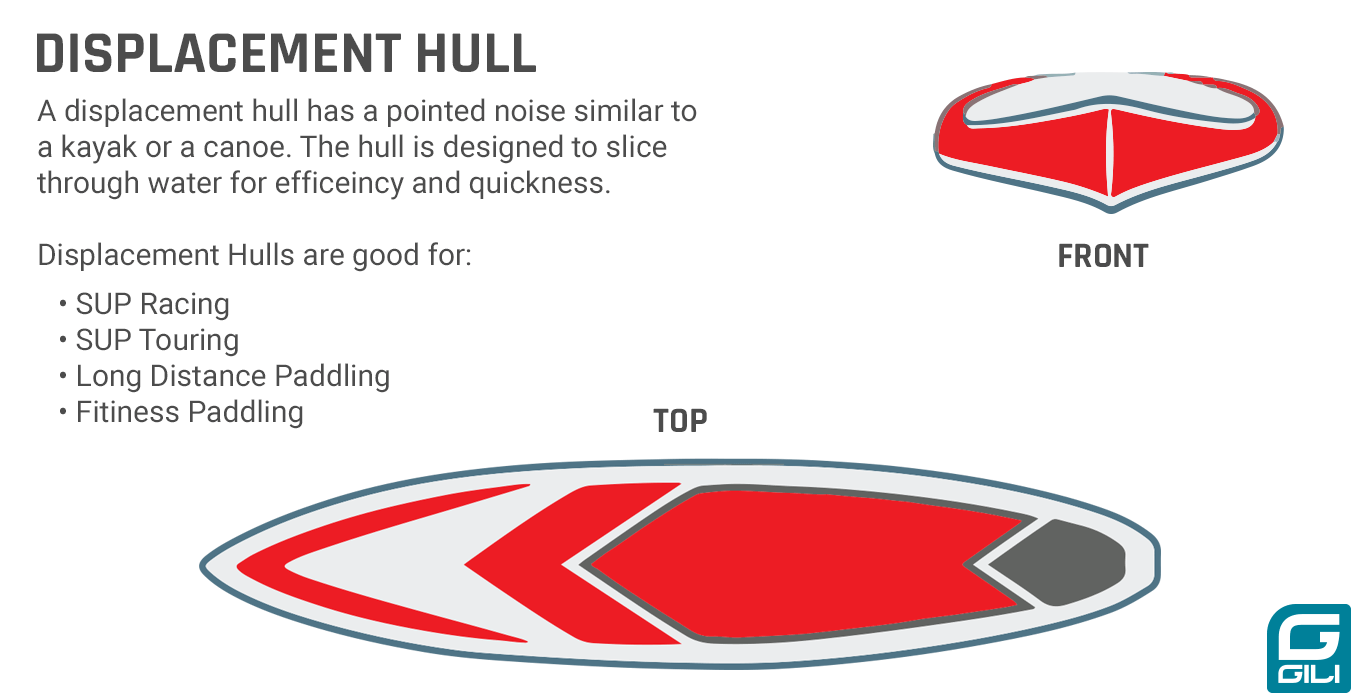
What do you weigh? Will you be carrying a passenger or any gear?
By far the most important factor is how much weight the paddle board needs to carry. If you weigh 160 lbs and your child is 75 lbs, you need a board that can accommodate at least 235 lbs. If you’re going to carry an extra gear, such as an ice chest, fishing poles, etc. make sure you factor those in. Make sure to err on the side of caution when looking at SUP weight limits - when in doubt go with a board that’s comfortably over the amount of weight you plan to carry.
Board Volume
Nearly all SUPs will have their volume listed. The volume is the length, width, and thickness of a paddle board. Clearly, the volume of the board is directly related with its ability to float. If you’re going to be shredding waves, you may want a little bit less volume than an all around board. The more experienced you are the less volume you can get away with. When comparing volume, remember that a board measuring 10’6 x 26” x 6” will have less volume, and stability, then a board measuring 10’6 x 33” x 6.”
But what volume paddle board should I choose for my weight?
For beginners who are looking for an easy paddle board to learn and have fun on, we recommend multiplying your body weight (in pounds) by 1 to 1.4. This will give you the idea volume range for your first board.
Example:
I weigh 160 lbs. At most I plan on carrying a 15 lb cooler with me. The total weight of me and my gear is 175 lbs.
175 lbs x 1.1 = 192L
175 lbs x 1.5 = 262.2L
I should be looking for a board between 192L and 262L. Our suggestion is to look for a board right around the 1.3L range. Our GILI 10’6 AIR Paddle Board or our GILI 11' Adventure Paddle Board would be a perfect fit for my weight.
If you’re a more experienced paddler, we have some guidelines to help you find the right volume for you:
Intermediate: Body weight x 0.8 to 1.1
Touring Paddle Boards: Body weight x 1.0 to 1.1
Yoga Paddle Boards: Body weight x 1.0 to 1.4
Surfing Paddle Boards - varies heavily depending on surf conditions and skill level: Body Weight x 0.5 to 1.0
Fishing Paddle Boards: Body Weight + Gear x 1.1 to 1.5
What Paddle Board Length Should I Choose?
The length of your paddle board plays a large role in how your board handles. Longer boards are faster than shorter boards, but a shorter board will be more agile and maneuverable. Your intended use is also important when choosing the length of your SUP.
Short paddle boards, under 10 feet, are great for surfing or for kids. Paddle boards under 10 feet will nearly always have a planing hull, and are very maneuverable. This makes these boards great for surfing waves. Usually you will find boards that are made for surfing AND for kids. Paddle boards designed specifically for children will usually be around 8’ feet long. White water paddle boards tend to be shorter as their short length makes maneuvering in rapids and white water much easier.
Medium length paddle boards, 10 feet to 12 feet, are excellent for all-around, recreational use and SUP Yoga. You’ll find most boards are between 10 and 12 feet, and you almost can’t go wrong with this length as a full-size adult.
Long Paddle Boards (longer than 12 feet) are great for touring, racing, and for fast paddling. These boards are faster than short and medium length boards and they track much straighter. If racing or long distance paddling is your thing, look for a board greater than 12 feet in length.
Remember, a longer board can increase volume and capacity, which also makes the board feel more stable and able to carry more gear.
Please use our Paddle Board Length Guide below to help you find the right size for you. Remember, include your weight plus the weight of any gear you'll carry.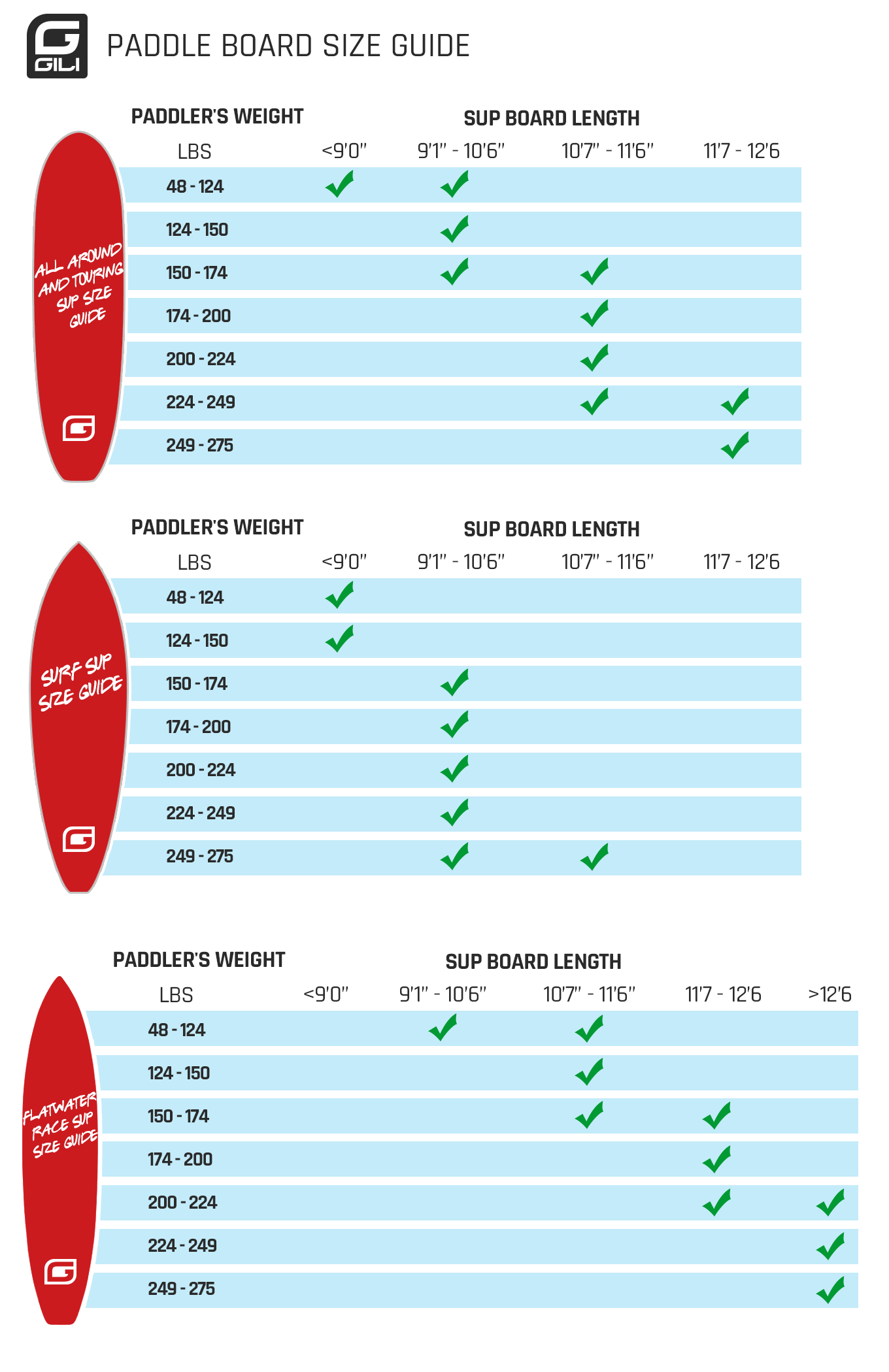
What Paddle Board Width Should I Choose?
Width is another important factor in how a paddle board handles. Wider boards are more stable than narrower boards, but wide boards can be slower. If you choose a board that’s too wide, you may actually find it difficult to paddle. Most SUPs range from 25 inches to 36 inches wide.
When choosing the width of your paddle board, think about what type of paddling you’ll be doing, your skill level, and your weight.
If you plan on carrying extra gear, a dog, or person choose a slightly wider board so you have more space and a bit more stability. If you’d like to use your board for SUP Yoga, you’ll want the extra space for poses. For this type of paddling we suggest using a board that’s 31” to 33” in with. If you carry a lot of gear, such as SUP Fishing, we suggest a board in the 33” to 36” range.
If you are an experienced paddler you may have more fun on a narrower SUP. If you’re a beginner, a little extra width goes a long way to make the board feel more stable on the water.
Again, try to match the board width to your weight and body type. If you’re a smaller person you can get away with a narrower board, and if you’re a larger person look for a wider board. While a small person can ride a wide board, paddling may become uncomfortable and is less than ideal.
What Paddle Board Thickness Should I Choose?
If you’re looking for an inflatable board, we always recommend at least 6” of thickness. We’ve found inflatable paddle boards under 6” thickness to be too unstable for a full-sized adult. Kids can get away with a narrower inflatable paddle board, but don’t go under 4” when shopping for a paddle board for your child.
Hard paddle boards come in a variety of thicknesses. The general rule of thumb is choose the thickness by the type of paddling you’ll be doing. If you go fast on flat water, choose a long, skinny paddle board.

Even though choosing a paddle may seem simple, there’s more to it than you may think. We’ll cover the basics of the SUP paddle, and help you figure out which one you should choose.
The anatomy of a paddle board paddle is simple: the handle, the shaft, and the blade . The handle is where your top hand rests, the shaft connects the handle and blade, and the blade is the part of the paddle that propels you forward in the water.
Most modern SUP paddles have handles with an ergonomic design for a comfortable fit in your hand.
The shaft, considered by most paddlers to be the most important part of the paddle, can be made from aluminum alloy, fiberglass, carbon fiber, or even kevlar. The material of the shaft makes a large difference in the performance of the paddle.
Stand up paddle blades can vary in size from large to small. Obviously, a larger paddle blade will displace more water, but can be difficult to paddle for beginners and can cause greater fatigue. Smaller blades are generally preferred for most people, including SUP surfing and all-around paddling. Larger blades are more desired for paddle board racing, touring, and downwind paddling.
Many paddle boards packages will include a paddle, however not all paddles are made the same. Whether the SUP package you’re looking at includes a paddle or not, here’s what to look for.
Travel Paddle, Adjustable Paddle, or Fixed Paddle?
Most inflatable board packages will include a 3-piece Travel Paddle that breaks down for easy storage. These paddles often come in aluminum, fiberglass, or carbon fiber with a nylon blade. Aluminum paddle shafts are typically found on more budget oriented packages, and fiberglass and carbon fiber shafts are found on more expensive SUP packages.
While we love 3-piece travel paddles for storage, they do come at the expense of adding a little more weight. A regular, adjustable paddle may be the choice for you if you’re not concerned about portability. Keep in mind that nearly all paddles, 3-piece or fixed, will have a broad range of adjustment for your height.
If you’re looking to save weight and to maximize performance, looked for a a fixed paddle with a carbon fiber shaft and blade may be for you. You can’t beat a full carbon fiber paddle in terms of performance, but remember they come at a price!
For most paddlers, we recommend at least an adjustable paddle in aluminum, fiberglass, or a carbon fiber shaft with nylon blade. If you’re looking to buy an inflatable paddle board, make sure it includes a travel paddle!
When choosing a SUP paddle, make sure it has enough adjustability for your size. Look for a paddle with an average size blade, unless you’re looking to maximize performance for SUP racing or long distance paddling.
Be wary of “cheap” fiberglass or carbon fiber paddles. You get what you pay for, and these cheap paddles my look nice, but they’ll typically have much more flex than their more expensive counterparts. Remember, paddle flex reduces paddling efficiency and power!
The height of your paddle is also very important. While many SUP paddles are height adjustable, make sure the length of adjustment is enough to accommodate your size.
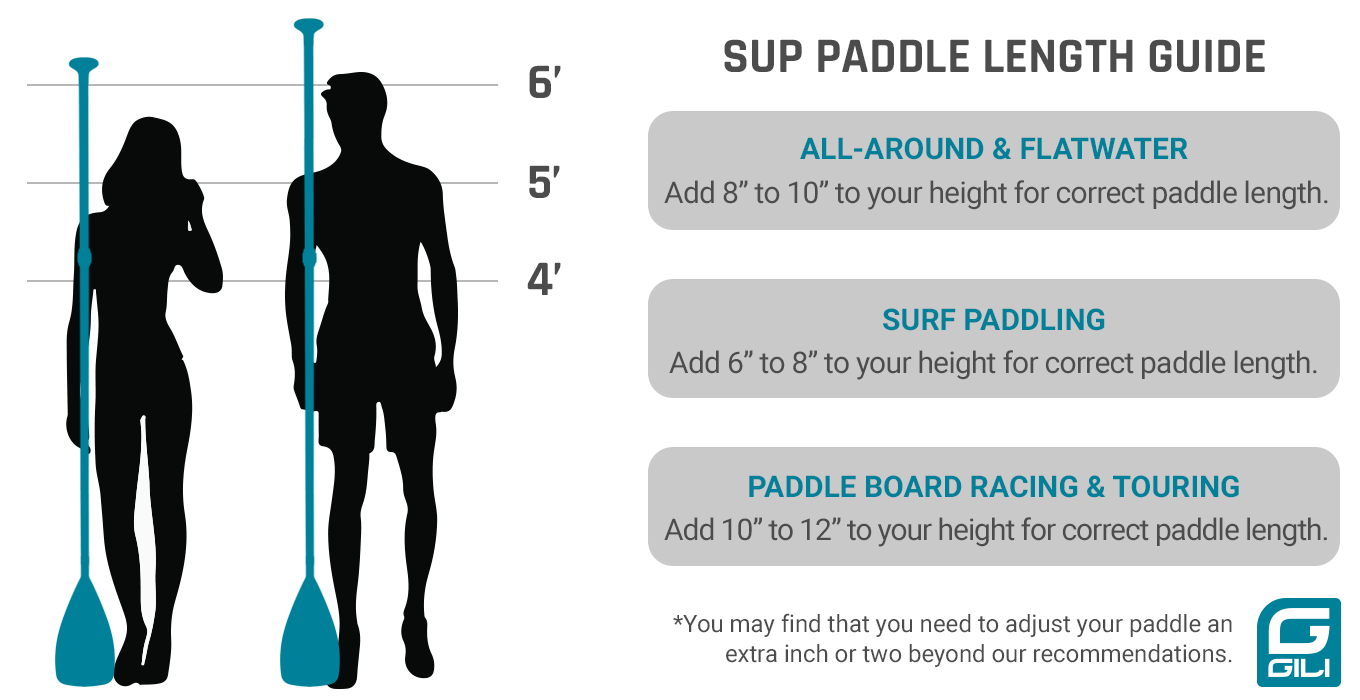
For maximum performance and comfort, you’ll need to choose the proper paddle height for the type of paddling you’ll be doing.
For all-around and flat water paddling, choose a paddle that’s about 8-10 inches above your height.
For SUP surfing, choose a paddle betwen 6-8 inches above your head. You’ll need a slightly smaller paddle for surfing due to crouched stance used in SUP surfing.
When paddle board racing, choose a paddle that’s 10-12 inches above your head for maximum power and reach where every bit of performance matters.
Of course, you aren’t ready to get on the water without a few additional accessories. You’ll at least need a paddle and leash, so consider the accessories that come with your paddle board. When budgeting for a new paddle board, don’t forget everything you need to have a fun experience on the water.
Paddle
You can’t get on the water without a proper paddle. A SUP paddle is a bit longer than a canoe paddle and will usually have a blade shaped like a tear drop. Most will angle slightly forward for better paddling efficiency. Many paddle boards come with a paddle, and some will break down for travel. Check out the SUP Paddle part of this guide for more information.
Bungee Straps
Often times a paddle board will have a built in bungee system, but you may want to add extra gear. It’s always have some extra bungee straps lying around when you need them.
Attachment Points
You may consider buying accessories, usually sold separately, for attaching a fishing rod, seat, or camera.
Life Jacket / Personal Flotation Device
Remember, the US Coast Guard considers paddle boards as a “vessel” when used outside of swimming or surfing areas, so they required you use a PFD (personal flotation device).
Leash
We strongly encourage you to use a Coiled SUP Leash at all times when paddling, especially in surf or white water conditions. A leash keeps your board tethered to your feet and close by in case you fall off.
Car Racks / Bag
If you’re buying a hard board consider how you plan on transporting it to the water: consider buying a roof rack and tie downs. If you’re purchasing an inflatable, make sure it comes with a bag for transport.
Just like their surf board brethren, paddle boards benefit from the use of fins for stability and tracking. Smaller fins provide better maneuverability, while larger fins track straighter and offer more stability. Many boards offer different fin setups. There a a few different paddle board fin configurations:
Single fin: probably the most common fin setup as a single fin provides good tracking and minimal drag. Single fin setups are an ideal choice for paddling on flat water.
3 Fin Setup: very common on surf paddle boards offering great control in surf conditions. Often called a thruster, you will find two different 3 fin setups: 3 fins of the same size and a large center fin with two smaller side fins.
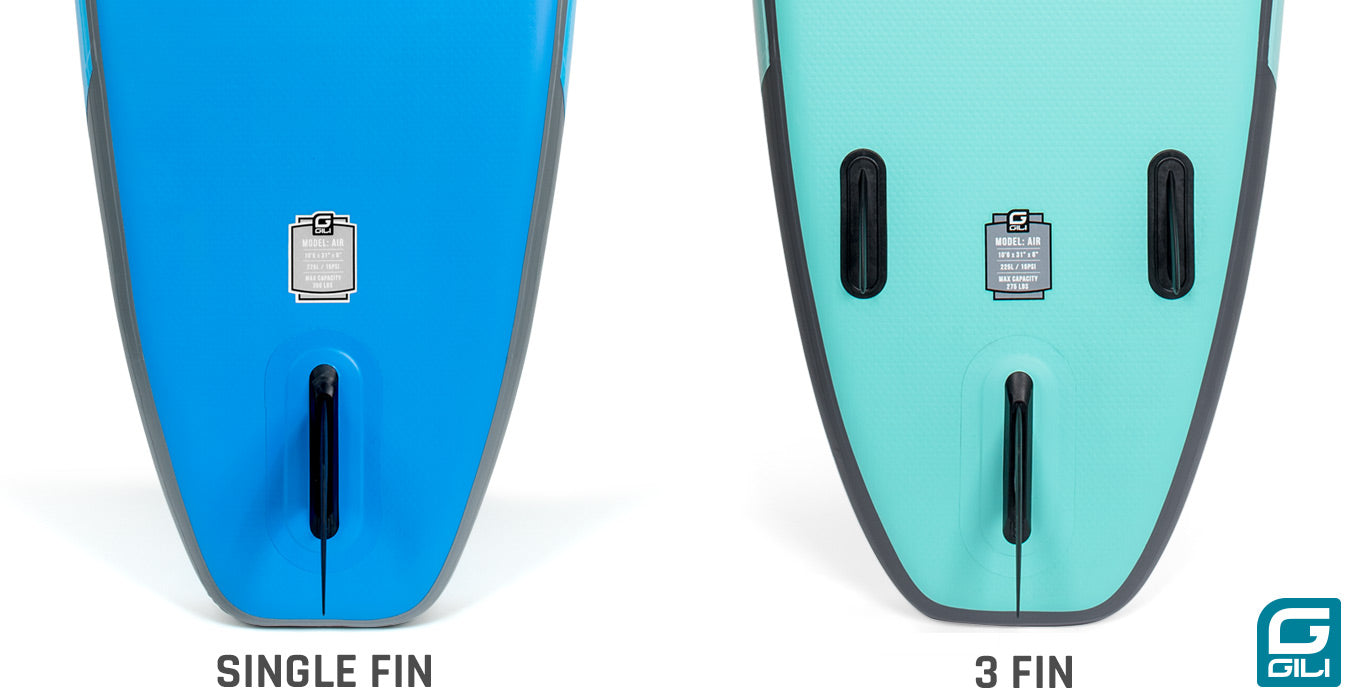
Inflatable Paddle Board Fin Setup: look for a paddle board with at least a detachable center fin. Sometimes manufacturers will offer two smaller, fixed, rubber side fins in a 2+1 setup. You can find an inflatable paddle board with three removable fins, but they are currently much less common.
Even though it may seem like it, inflatable paddle board pumps are not all alike. You have some that are single chamber, dual chamber, triple action, and electric pumps. Below you’ll find everything you need to know about paddle board pumps.
Nearly every type of pump should have an included pressure gauge. Keep in mind that with most paddle board pump pressure gauges the needle will not move until the board has reached over 7-8 PSI.
Single Stage Hand Pump: a single stage pump only pumps air on the down stroke of the pump. Cheaper paddle board packages will have a single stage pump.
Pros: Simple and lightweight, cheap
Cons: Takes many more pumps and a longer time to inflate than other types of pumps
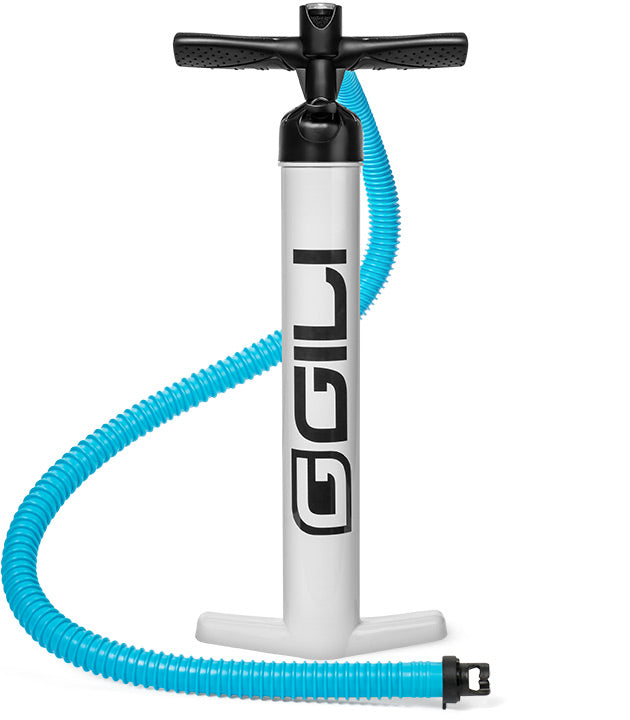
Dual Stage Hand Pump: a dual stage hand pump pumps air on the upstroke and downstroke during pumping. Most of them will have a small, plastic key you can remove to convert the pump into a single stroke action pump. This is a great feature as pumping the final few PSI into your board can be a bit difficult in dual action mode. Look for a dual stage pump in higher end inflatable paddle board packages.
Pros: great for pumping up your board quickly. Single stage mode allows for easier pumping at higher pressures. Light and affordable. The most common pump type, and highly recommended.
Cons: slightly more expensive than a single stage pump
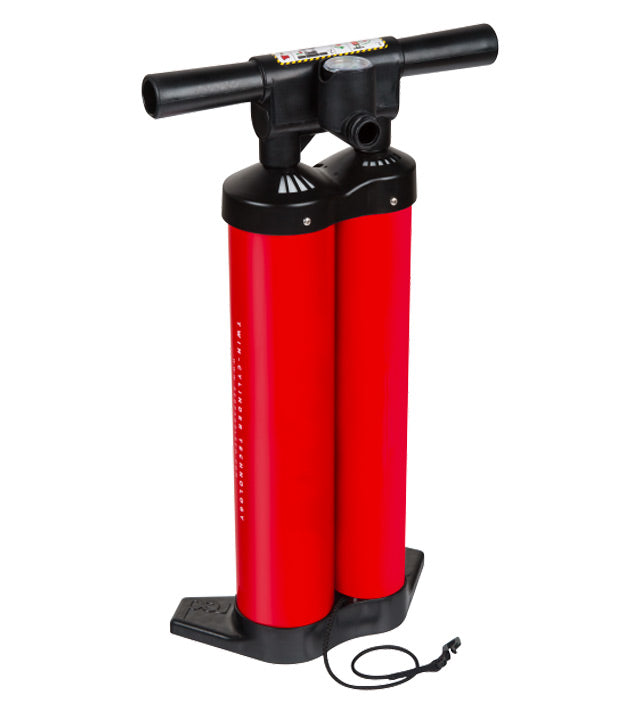 Triple Action Dual Chamber Hand Pump: these pumps are huge, but offer dual chambers for the quickest iSUP inflation times of all three types of pumps. Most of these pumps have a dial with three settings: one setting for pumping the maximum amount of air into the board, a second setting for medium pressure, and a third for pumping the last bit of PSI into your board. These are typically found on medium to high end inflatable paddle boards.
Triple Action Dual Chamber Hand Pump: these pumps are huge, but offer dual chambers for the quickest iSUP inflation times of all three types of pumps. Most of these pumps have a dial with three settings: one setting for pumping the maximum amount of air into the board, a second setting for medium pressure, and a third for pumping the last bit of PSI into your board. These are typically found on medium to high end inflatable paddle boards.
Pros: Two high volume chambers for very fast board inflation, three different pressure settings
Cons: Heavy, bulky, and expensive
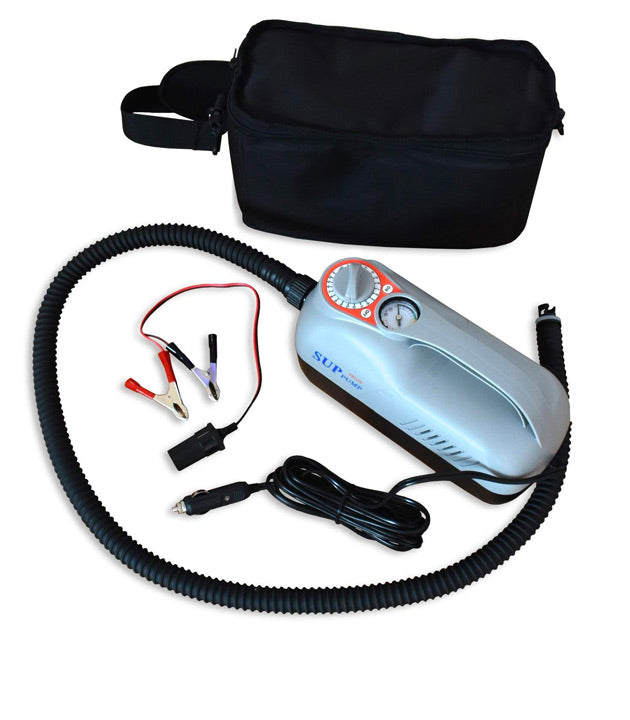 Electric Paddle Board Pumps
Electric Paddle Board Pumps
Several manufacturers also offer electric paddle board pumps. Typically, these will connect to your car or auto battery, and they have a range of PSI settings. Look for one that offers a 12 PSI to 15 PSI range (or higher if your board requires it). These pumps will stop automatically once the specified pressure has been reached. Some electric pumps can reverse the airflow and deflate your board, but we have found this feature to be unnecessary.
All electric pumps should come with everything you need to hook up to your vehicle or car battery, pump hose, and the necessary fittings for different types of inflatable paddle boards.
When looking for an inflatable paddle board pump look at the inflation time, PSI range, included accessories, and warranty.
Pros: Easily inflates your board to the desired PSI. Typically fast. No hand pumping required.
Cons: Heavy, needs to be hooked up to your car or battery, expensive.
We have yet to review electric paddle board pumps ourselves, but we will update this guide when we do.
Shop Inflatable Paddle Board Pumps
Other Methods of Inflation
You can purchase an iSUP valve adapter for your air compressor or bike pump. However, you need to be very careful when not using a pump that’s not specifically designed for paddle boards. Never over-inflate your board for risk of damage or bodily injury. If you’re using an adapter with an air compressor or bike tire pump, be sure to frequently check the pressure of your board. We’ve found that while air compressors can quickly inflate paddle boards they aren’t the safest method of inflation. In our testing, using a bike tire pump for paddle board inflation was very inefficient. We do NOT recommend pumping your board up with an air compressor, bike tire pump, or with similar types of pumps.
Remember, when shopping for an inflatable paddle board, not all iSUP bags and backpacks are made equal. Having a great bag for your iSUP makes transporting your board much easier. Be aware that some boards do not come with it’s own carrying bag.
The best bags have a large, zippered compartment that can fit your board, hand pump, fin, leash, and paddle. Our favorite bags also have an outside mesh sleeve with straps, which we’ve found is great for holding our paddle on the outside of the bag.
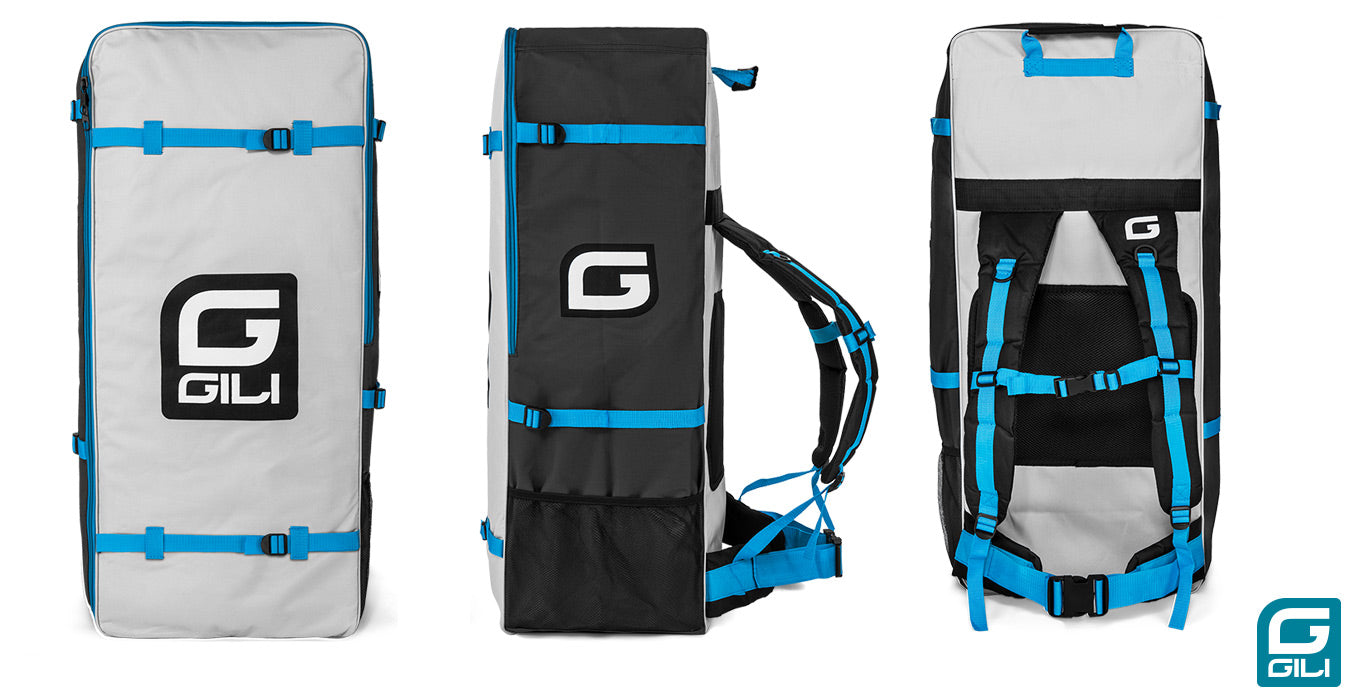
A high quality bag will also have padded shoulder straps, a waist strap, and usually a sternum strap. Even though inflatable paddle boards aren’t super heavy, we’ve found extra padding and waist strap to be extremely useful.
We’re not fond of bags that wrap around the paddle board, or very simple, cheap mesh bags. Most iSUP packages should come with a bag, but make sure it’s a quality bag. Every time we have to walk a short distance to the water, we’re very grateful that our paddle boards came with nice bags.
Shop Inflatable Paddle Board Backpacks
As an observer who’s never tried, paddle boarding may look simple. Although standing up and paddling on a board is not difficult, there’s more to the sport then you may think.
We’re going to cover everything from the very basics of paddle boarding, such as riding position, stance, kneeling, and launching your board to the more advanced paddle board techniques you can use as your skills increase.
Paddle boarding can be a relaxing, comfortable and casual sport, but with the proper knowledge and technique you’ll get even more enjoyment out of this wonderful sport.
Getting Your Board to the Water
If you’re using a hard paddle board, carefully remove the straps securing your paddle board to your roof rack, truck, etc. We suggest asking another person for their help in order to get your SUP off of its rack. Have one person grab the tail of the board while you grab the nose, and carefully lift and set the board on a soft piece of ground. If you have a board bag, we like to lay the board bag on the ground and set our boards on it.
If you have an inflatable, grab your iSUP bag and head on down to the water. If the area near the water lacks a suitable area for inflation, you may want to inflate the board near your vehicle. We suggest using a soft, grassy area for inflation. If you must inflate the board on cement or asphalt, use a large towel or board bag to avoid dirt and scuffs.
How to Carry your SUP
Almost all stand up paddle boards have a carry handle in the middle of the board. This makes carrying a SUP, hard board or inflatable, pretty straight forward.
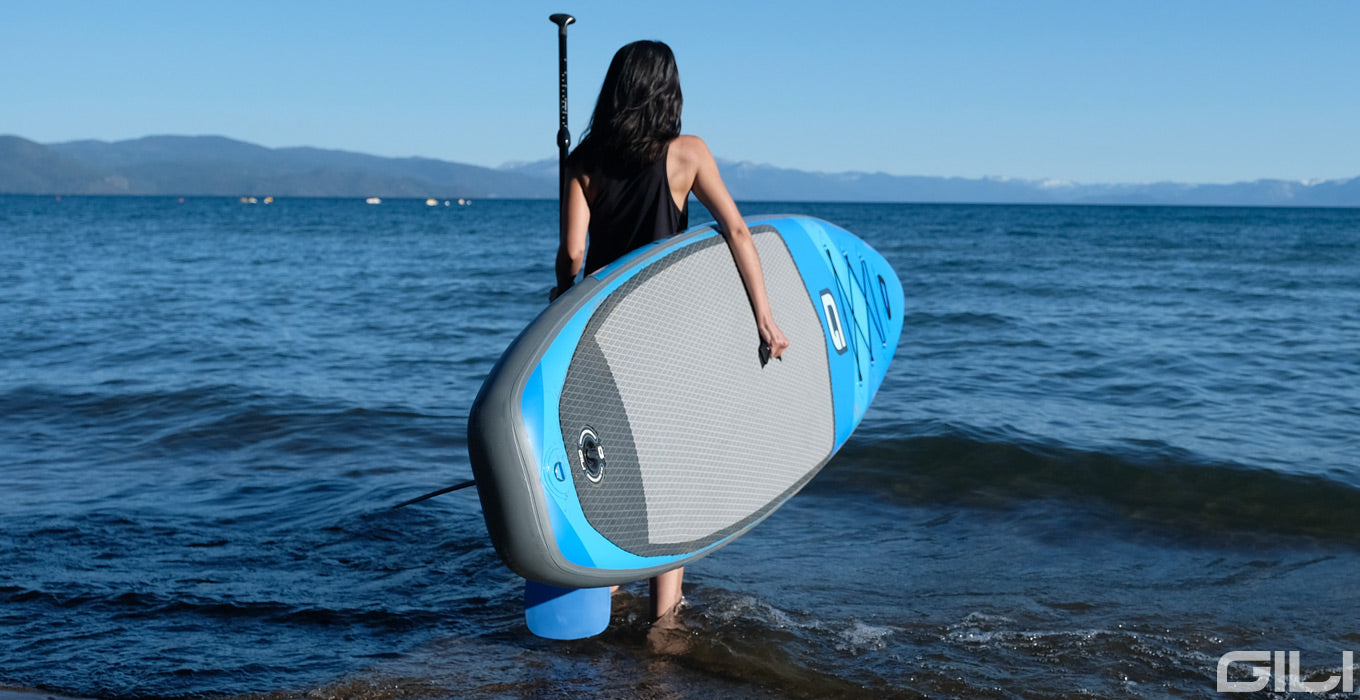
Tips for Carrying Your Paddle Board
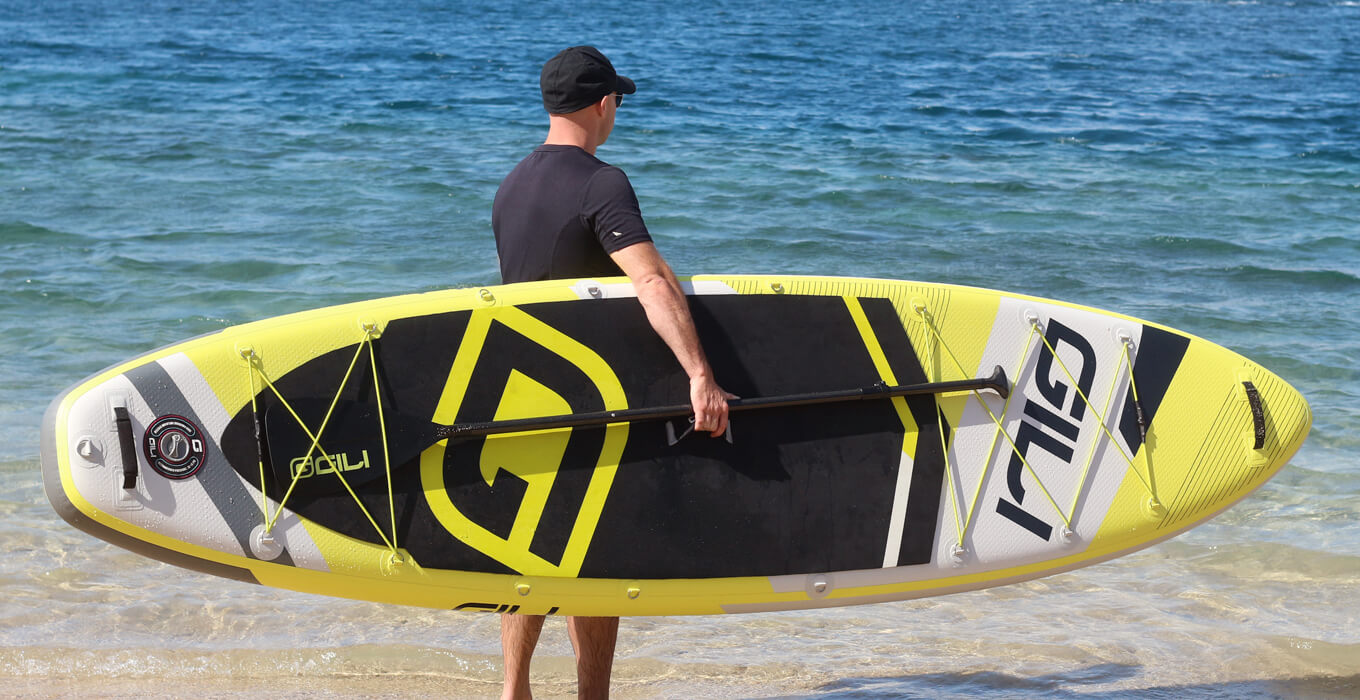
How to Properly Launch and Stand Up On Your Board
Once you’ve gotten you and your board safely to the water, it’s time to launch your board. Here are a few tips and tricks to help you get on the water without damaging your board or falling into the water.
Do not install your fin until you’re ready to launch. It’s easy to damage your fin or your board bry dragging the fin on the ground or in shallow water. Be very careful when carrying your board with fins attached.
When you’re ready to launch, securely strap the leash to your board and ankle. You should have enough room to maneuver on and around the board with a proper paddle board coiled ankle leash.
When launching your SUP from the shore, we suggest carrying the board until the water is about ankle deep. This insures your rear fin will not scratch or dig into the shore. It’s time to mount your SUP. We like to hop on our knees on the board, and use forward momentum to propel us away from the shore. If this method isn’t for you, simply mount your board on your knees and use your paddle to get a comfortable distance away from shore.
Standing Up on Your Paddle Board
Now, you’re ready to stand up! Make sure your center of balance and feet position are centered in the board both horizontally and vertically. When you feel comfortable, slowly stand up on your feet while keeping your knees slightly bent. Instead of standing up in one motion, start by raising your chest. Keep your hands on each side of the board while bringing one foot forward at a time. See - that wasn’t too hard, was it?
Keeping your knees bent helps you cushion any oncoming waves. You’re now riding a stand up paddle board! It often helps to brace yourself with your arms when standing.
If you feel like you’re losing your balance you can go back to a kneeling position and paddle from here. You may way want to adjust your stance and center of balance before attempting to stand again. That’s it - you’ve now launched your board and are in the proper standing paddle board position. You’ll discover that riding a SUP is really not that difficult!
Proper Paddle board Stance and Positioning
Using the proper stance and positioning will help maximize your paddling and balance on the water. You want to make sure your knees are slightly bent, and that your position the board, vertically, is around the center of the board. Typically, your feet, parallel to each other, will be near the center grab handle of the board. Some paddlers prefer to be a little forward or backward of the board’s center of gravity. Experiment with your feet placement to see what position you like best.
Staying Balanced on Your Paddle Board
Follow these tips to stay balanced on your board:
How to Adjust a SUP Paddle for your Height
Using a paddle that’s the proper height for you will improve your paddling and make your SUP experience more enjoyable. Most SUP paddles feature a range of adjustment to accommodate tall and short paddlers. Keep in mind that you may use slightly different paddle lengths for paddle board. Here’s the rule of thumb for properly adjusting your SUP Paddle.
For general paddling, your paddle handle should be about 6 to 8 inches above your head. When paddling, you are looking for a compromise of not bending over too much and being able to swap sides easily. You should be able to hold the paddle comfortably with the blade submerged. The handle should be no higher than eye level when you are mid-stroke.
If you ask Laird Hamilton (a world famous stand up paddler), he recommends a paddle length of 3-4 inches above your head. We’ve used both 6 to 8 inches and 3 to 4 inches. Use what’s most comfortable for you.
An alternative method for sizing your SUP paddle is the hands up method. Raise one of your arms up like you were doing a pull up. Use your other hand to hold your paddle upright. Adjust your paddle to the height of your hand that’s in the air. The paddle handle should fit comfortably in your free (raised) hand.
How to Hold a SUP Paddle
Most newcomers to paddle boarding hold their paddles the wrong way. We’ll show you how to hold a SUP paddle the right way. Also, make sure your paddle is properly adjusted for your height before you attempting to paddle.
Always hold the paddle by gripping the top of the paddle with one hand and the other holding the center of the shaft. The blade of the paddle should be angled away from you towards the front of the board.
When you’re paddling on the left side, your right hand will be on the t-handle and your left hand will be on the shaft of the paddle. Reverse your hand position when you switch sides.
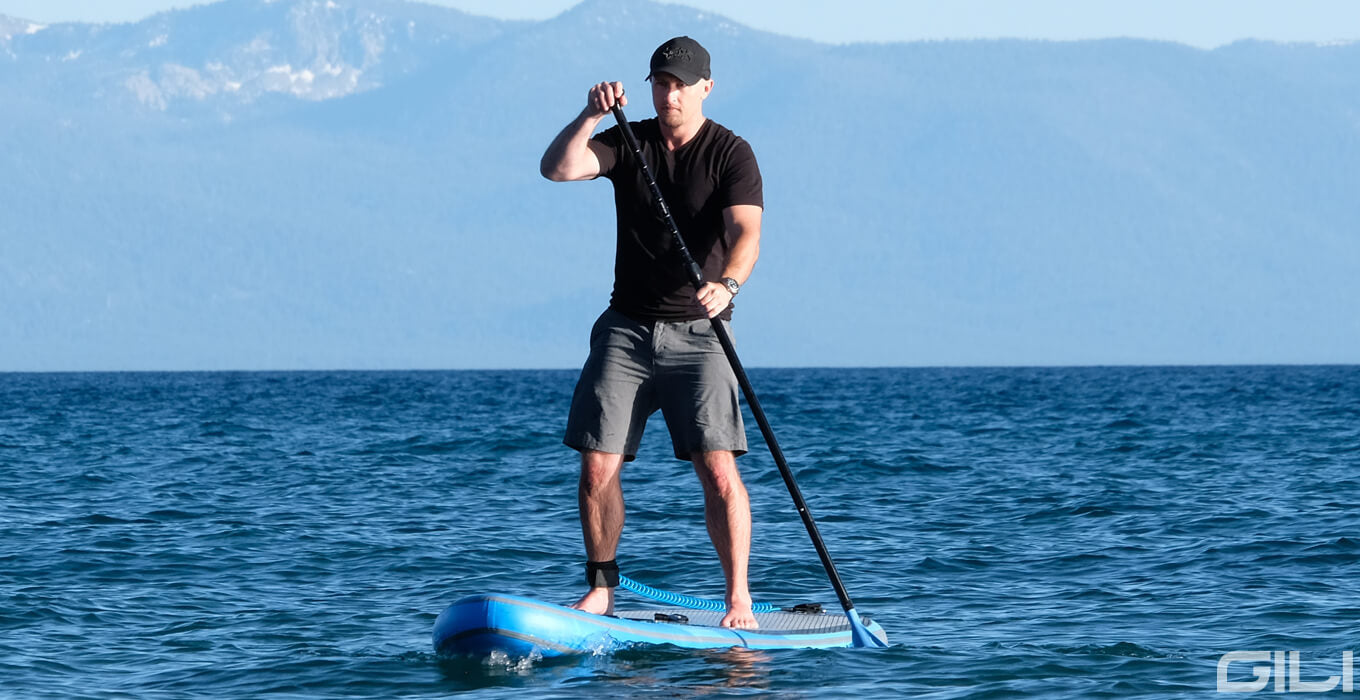
Hold the paddle in front of you - your elbows should bend around 90 degrees.
Remember, your paddle should float in case it falls. If you drop your paddle in the water it’s no big deal!
Ok, now the fun begins. There are 3 basic strokes every beginner paddlers should be familiar with and practice.
Forward Stroke
This basic stroke does exactly what it sounds like: it propels you and the board forward.
Start by reaching with the paddle about two feet forward, and push the entire blade of the paddle under the water’s surface. Move the paddle back through the water towards your ankle and then out of the water.
Reverse Stroke
The reverse stroke is basically the opposite of the forward stroke. Use the reverse stroke to slow down, to stop, or to turn.
Sweep Stroke
You should use the sweep stroke to turn your board while standing still or in motion.
Check out this video for a demonstration of the Forward, Reverse, and Sweep Strokes.
Avoid These Common Paddling Mistakes
Sitting or Kneeling on Your Paddle Board
If you’re feeling tired, or just want to relax, it’s perfectly OK to sit or kneel on your board. To transition from a standing to kneeling stance, simply secure the paddle with one hand, or place it on the front of your board), and use your free hand to steady yourself, and simple kneel down one knee at a time. From there you can get into a comfortable sitting position.
Falling Off and Getting Back On Your Paddle Board
Even experienced paddlers fall off their boards, so you should be prepared for when that inevitable fall happens. If you’re feeling a little shaky, remember SUP is a water sport, you’re meant to get wet! There’s no shame in falling (or jumping) off your board!
If you lose your balance and feel yourself falling:
How to Get Back on Your SUP After a Fall
Remember to wear your SUP leash at all times, they can really make falling off and mounting your SUP a lot easier!
Common Paddle Boarding Mistakes & Tips For Your First SUP Outing
Wait! Read these tips before you grab your board and head for nearest body of water!
Alright, you’ve gone paddle boarding a few times and you’re ready for more. Here are some advanced techniques you can try the next time you’re on the water.
Advanced Paddling Technique
Once you’ve got the basics, it’s time to put some more power into your stroke. Remember, think of of paddling as if you were pushing the board past your paddle. Extend your reach as far as you can without losing your balance, with your feet in the standard position (parallel in the middle of the board). At the end of your reach, bury the blade completely in the water - this is called the “catch.” Time to for the advanced part of the paddle: the more your top hand is over the bottom hand the straighter the board will go. The blade of your paddle should come out of the water near your feet; anything past your feet is causing too much drag.
Remember these three things for a more powerful, advanced stroke:
Most of the entry and the exit are controlled by the top hand moving a cross and then dropping down. To put a little bit of more pressure and power into the stroke, you can start to sink your weight on to the top of the blade. Remember, you need to have a stacked paddle (hands vertically aligned on the paddle during the stroke) for this to work well.
As you start to master this advanced paddling technique, you can start to vary it depending on conditions. The main reason you may want to modify this stroke is wind. If you’re paddling into the wind and you want a little more power, try dropping your bottom hand a little bit lower. The lower your bottom hand, the lower your torso gets, the more power generated into the stroke. It’s important, whether you’re paddling in the normal position or the lower position, to keep your bottom hand loose. This will help you maintain a good reach in your stroke, and also help you stay loose and help prevent your hand from cramping.
The Step Back Turn
The step back turn is a great way to turn around quickly in any condition. With this turn you’re going to change feet position, so practice this first in a calm, flat water environment.
Start with your paddle on your leash side. Your non leash foot will move into the middle of the board, and you step back with your leashed foot. To turn the board, take wide strokes on your leash side. The more you shift your weight on your back foot, the sharper you can turn the board. Try to look towards where you want to go. To come out of the step back turn, bring your leash foot forward back into the parallel stance keeping your paddle blade nice and wide. One thing to remember, to position your feet to make the turn, both feet and toes are facing across the board, almost on the center line of the board. Don’t use your heels to turn - there should be a little bit of pressure on your toes to make sure the heel edge of the board doesn’t catch when you’re turning.
To take this technique a little further, rather than taking small strokes, you can take one giant stroke completely around the board. In other words, the stroke will start on your leash side, and you will complete the stroke by paddling around the rear of the board and completing the stroke on the opposite side. Remember, the wider the blade the better the turn.
The Paddle Slap
A paddle slap is a form of brace. It’s a low brace on the water to try and give us a little extra stability. We’ll use it in some of the advanced techniques here, when doing u-turns, in the surf, in choppy water, and any other time we need that extra stability. How do you perform the paddle slap?
You are looking to slap the logo side of the blade down against the water. Your knuckles should be facing down, and your knees bent to keep your center of gravity low. The wider the blade, the flatter it is on the water, the more stability it will give you. Try to drop the handle as well as the blade: your entire paddle should be in a low position almost parallel with the water.
Master this technique as we’ll use the paddle slap often in these advanced paddling techniques.
The Nose 360
The nose 360 will combine some of the advanced paddling skills you’ve learned. This technique will test your balance on the board, so be prepared when you practice this skill. Where a personal flotation device, and only attempt to learn this technique on calm, flat water clear of any obstacles such as boats, buoys, and other paddlers. You’re going to use the paddle slap you learned during this technique, so get ready!
How to perform the Nose 360:
If you fall off or have a hard time mastering this technique, don’t be discouraged! This is an advanced technique that will take you time and practice to master.
The Reverse Paddle Turn
The reverse paddle turn is a great way to turn around without having to move our feet or change the trim of the board. You also get to turn without having to change hand position or paddle on a different side. This is a quick and efficient way to turn and to control your speed.
How to perform the reverse paddle turn:
From a normal paddling position, bring the paddle out in front of you and bring your top hand into your hip. Then, rotate your upper body with your shoulders and your hips. Bring the blade all the way over the nose of the board to the other side with the logo facing towards the tail. Slice your blade into the water and start pushing the water back towards the nose. Practice this technique to master it.
To make this turn sharper, you can start to play with the trim of the board. You can step back with your leash foot, but use the reverse paddle turn to turn even tighter.
So you want to ride your paddle board with a passenger? Whether your paddling with a friend, child, or a dog follow these tips for a smoother ride.
You’ve made a significant investment in your paddle board and gear. Follow these guidelines to preserve your board and gear for many years to come. Remember, the elements can cause damage on any man made item, particularly sunlight and salt water. Even though your boards are made to be used out doors, here are some guidelines you should follow when not using your paddle board.
How to Avoid Sun Damage
Both hard paddle boards and inflatable paddle boards can be damaged by excessive sun, particularly when not in use. Follow these tips to avoid sun damage when not using your paddle board
Inflatable Paddle Board Care
Most inflatable paddle boards are made from military grade PVC, and can withstand most scratches and abuse. However, rough contact with rocks, glass, and sharp edges can puncture the outer skin. You can attempt to repair the board yourself as most iSUPs include a repair kit. If the damage is more extensive, you should seek a professional at a boating shop to repair your board.
Follow these guidelines to keep your inflatable paddle board in tip-top shape for many years of excitement and adventure on the water.
Caring for your inflatable paddle board is pretty simple: using common sense and a little effort will go a long way in keeping your SUP in excellent shape for the years to come.
Hard Paddle Boards: Dings and Damage Care
Like an inflatable paddle board, hard SUPs are pretty easy to take care of. Here are some guidelines to protect your investment so your board will give continue giving you years of fun.
Vent Plugs on Hard Paddle Boards
Vent plugs are designed to to allow air to escape freely through a water tight seal. Air can pass out, but no water is allowed inside. This is what keeps your hard paddle board safe from water damage and delamination. Obviously, inflatable paddle boards do not need to utilize a vent plug.
Don’t overthink caring for your paddle board - caring for your board is pretty easy. If you use common sense and some effort, you’ll get many years of enjoyment from your hard SUP. If you have any questions about caring your paddle board, post in the comment section below or contact us.
How to Repair Your Paddle Board
It’s always best to have a professional repair your board. However, if you have a minor dent, ding, scratch or tear on your paddle board, keep reading. Leave the big repairs to the professionals!
Repairing your paddle board is beyond the scope of this guide. Please follow the links below on how to repair your hard and inflatable paddle board:
How to Patch Your Inflatable Paddle Board
How to Repair a Ding in Your Hard Paddle Board
How to Repair a Crack in Your Hard Paddle Board
Let’s be honest, pumping up your inflatable paddle board is probably your least favorite part of a day out on the water, even if it’s a good workout. While most inflatable SUP hand pumps work great, here’s what to look for if you’re in the market for an electric paddle board pump.
Remember, inflatable sups hold a lot more pressure than an inflatable kayak, an air mattress, and other inflatable products. You’ll need an electric pump that can inflate your board anywhere from 12-15 PSI.
What to Look for in an Electric Paddle Board Pump
Here's our Favorite Inflatable Paddle Board Pump:
Storing your paddle board properly in those winter months will help you maximize its lifetime and longevity. Follow these guidelines to keep both your inflatable paddle board or your hard board in pristine shape for next summer!
• Store your board in a cool, dry place away from the elements such as your garage, house, or shed.
Follow the guidelines above and your board give you many years of use. Remember to keep your board out of sight to prevent thieves from stealing your board. If you can’t store your board in a garage or safe place, you can thread a security cable through one of its d-rings, or you can buy a lock specifically designed for a SUP.
Just bought a paddle board but haven’t thought how to properly transport your board without damaging it? Read on for the best way to transport your hard SUP.
If you have a truck, you can carry your paddle board by placing the tail of the board at the front of the bed (near the cab of the truck) and resting the nose of the board over the tailgate. You’ll want to use padding on both the tail and nose of the board to prevent damage. Make sure you strap your paddle board down to prevent from moving. You want the board to be snug so it doesn’t move, but don’t over-tighten your straps or you could damage the board. You can also purchase a paddle board / surf board mount that allows you to mount your paddle board elevated over the cab and bed of the truck.
If you have a smaller vehicle without a bed such as a sedan or SUV you’ll most likely need a roof rack to transport your paddle boards. Since we can’t cover all makes and models of cars here, we suggest finding a roof rack specifically designed for your car that can safely carry your paddle board. You’ll also need two cam straps, per board, about 12 feet in length or longer to secure the board to your rack.
These days you can even find universal, inflatable roof racks or soft roof racks that are easy to install and are compact to store in the car when not in use. Although soft and inflatable racks are convenient, they are not as sturdy as a hard rack. Make sure to use very good, high quality cam straps when using an inflatable or soft rack.
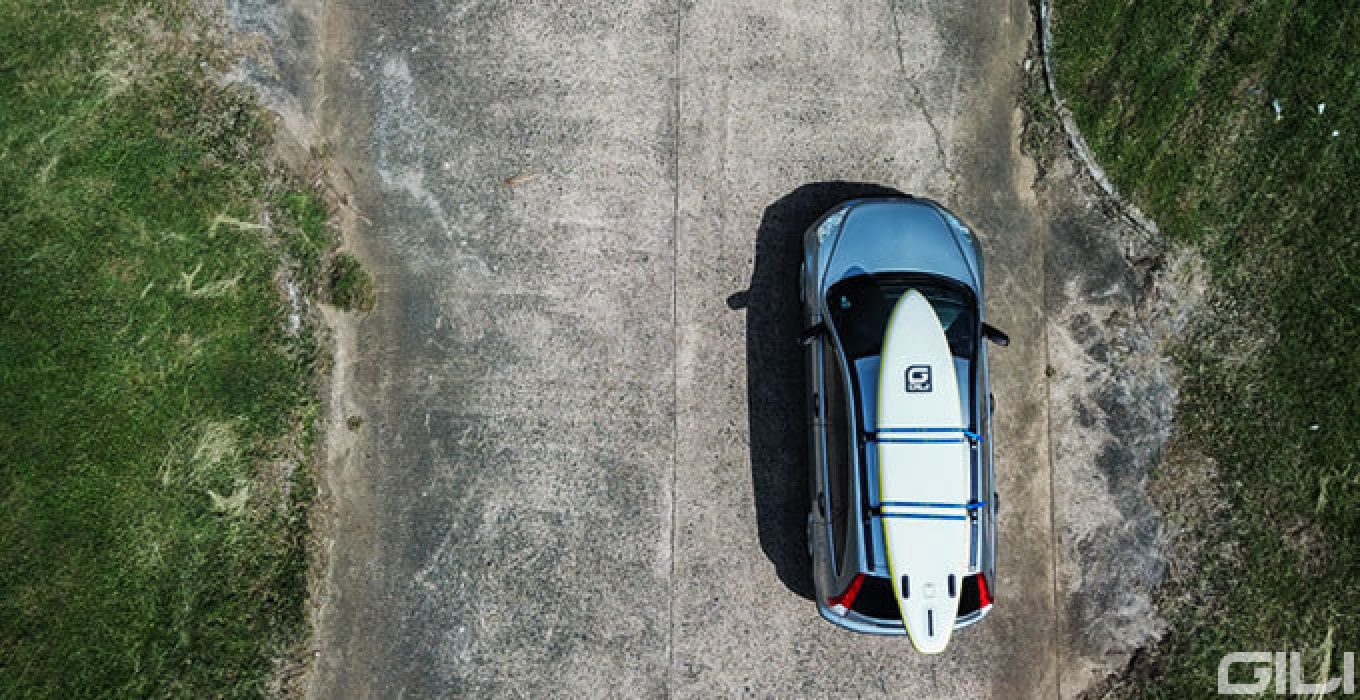
If you’ve got a large van you can store your hard paddle boards inside! Vans are the ultimate carry all paddle board vehicle! Just make sure your secure your boards from jumping or moving around while in transit.
Inflatable paddle boards are designed for the ultimate portability. Almost all will come with backpack or bag designed to carry your iSUP and all its gear. However, there may be times you want to travel with the board inflated or without the bag.
This concludes the Ultimate Beginner’s Guide to Stand Up Paddle Boarding. You should now feel confident in purchasing a paddle board. Once you’ve got your SUP, you should now feel comfortable enough to hit the water and start paddling!
Los comentarios se aprobarán antes de mostrarse.